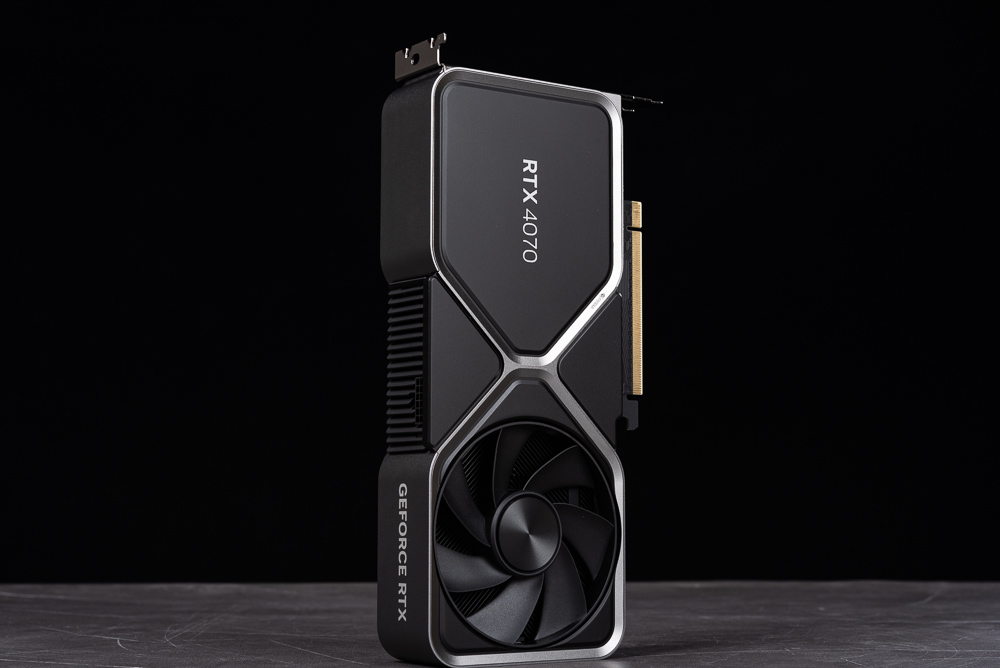
Retailing at $599, the next-gen NVIDIA GeForce RTX 4070 graphics card surpasses the RTX 3070 Ti with an 18% overall gaming performance boost and a 42% improvement in ray-tracing performance, all while consuming only 200W of power. It even attains an average of 115 FPS in 2K resolution ray-tracing games. The cutting-edge Ada Lovelace architecture delivers enhanced gaming performance per watt, ushering in the era of AI-assisted frame acceleration with DLSS 3.
83% of RTX 40 series players turn on ray tracing, 79% turn on DLSS, and 28% are 4K players
In 2018, NVIDIA unveiled its first-generation RTX technology, paving the way for real-time ray tracing in gaming and introducing AI acceleration through DLSS. Now, with the advent of third-generation RTX, a multitude of NVIDIA technologies are combined, providing game developers, game engines, simulation, and rendering applications with more realistic and efficient ray tracing rendering capabilities.
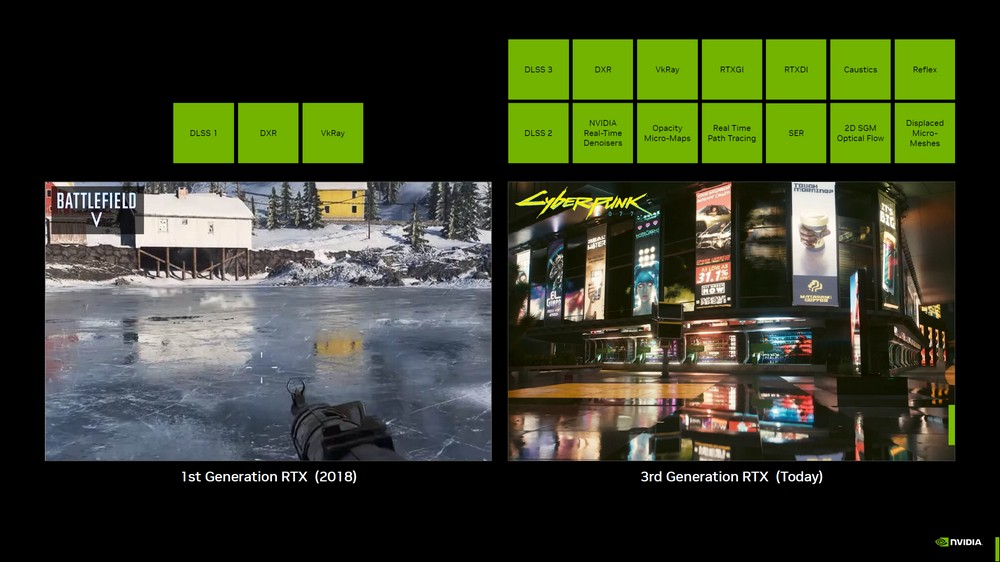
NVIDIA has shared some intriguing statistics as well. When the first-generation RTX 20 series launched, only 37% of gamers enabled RT ray tracing, and 26% activated DLSS acceleration. This suggests that the technology was not yet mature, and the adoption rate among players was relatively low. Fast forward to the latest RTX 40 series, 83% of gamers now enable RT ray tracing, and 79% turn on DLSS acceleration.
Furthermore, 62% of RTX 40 series users have esports monitors with refresh rates above 144Hz. Interestingly, only 28% of 4K gamers use such monitors. This indicates that the prevailing esports display specifications are primarily focused on 1440p and 1080p resolutions, with refresh rates generally above 144Hz.
Since the release of “Battlefield V,” which supported ray tracing, in 2018, each pixel has required only 39 ray tracing calculations. However, in “Cyberpunk 2077,” full ray tracing necessitates 635 ray tracing calculations per pixel—a 16x increase in demand for ray tracing computation in just three years.
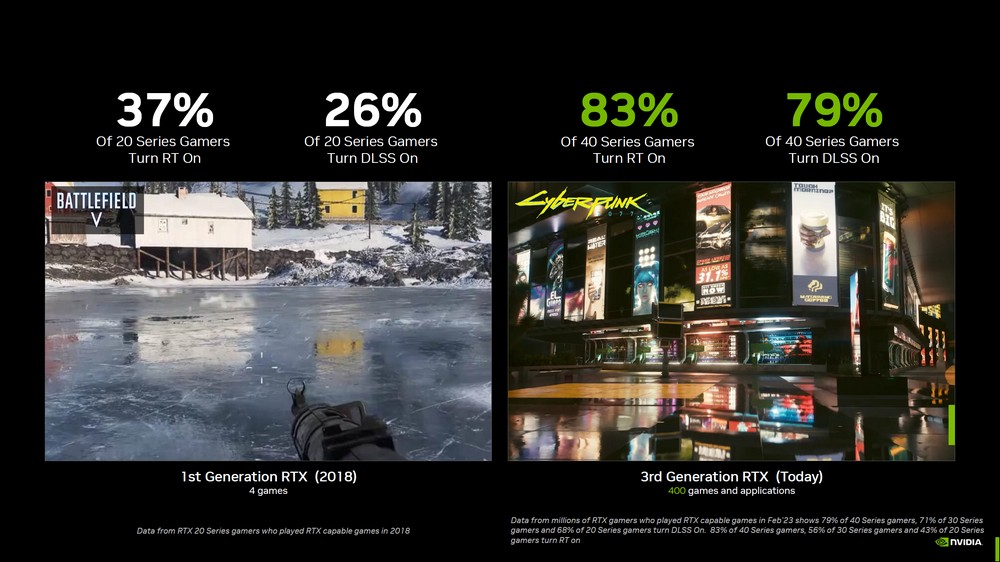
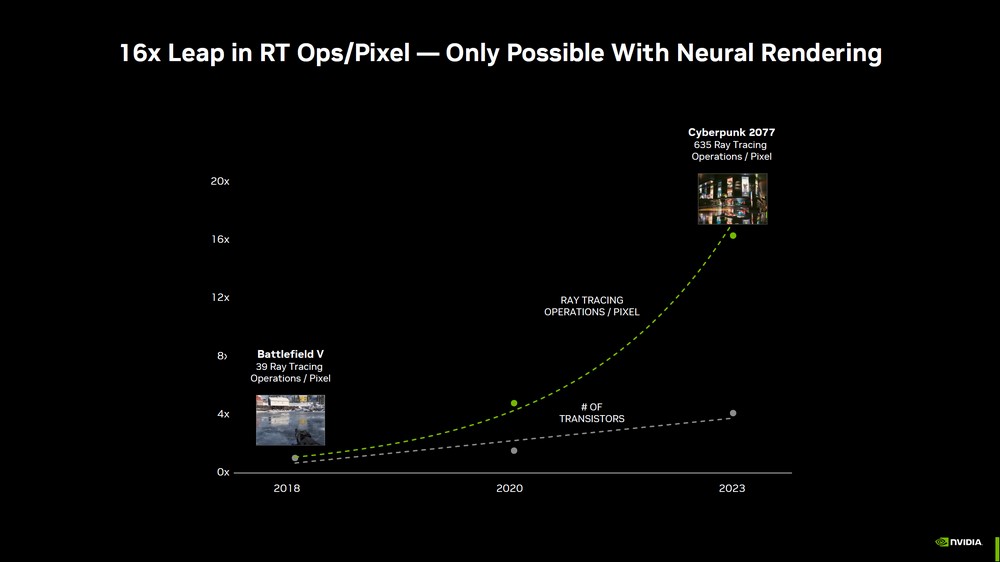
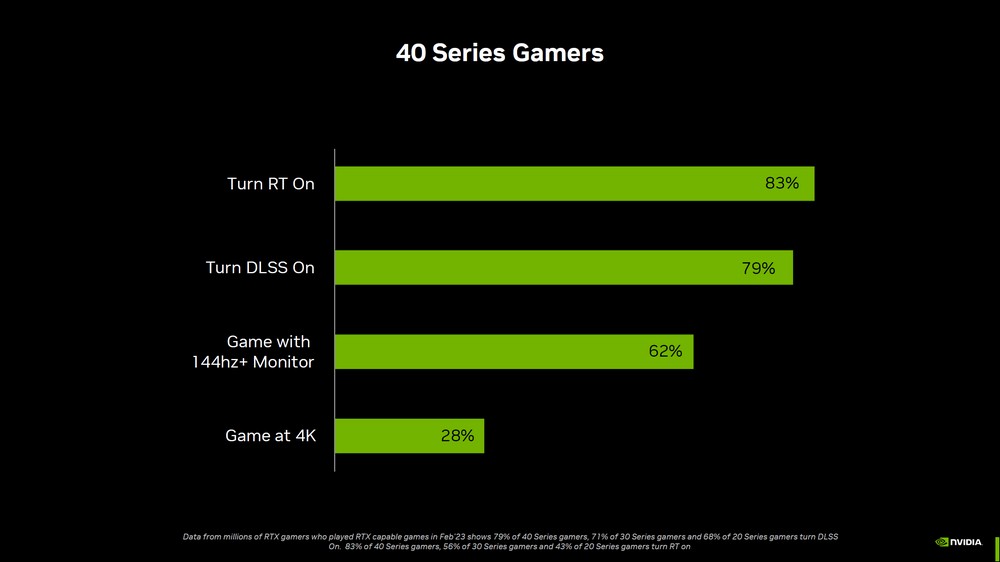
NVIDIA GeForce RTX 4070 Debuts 2K@100fps+ Ray Tracing, DLSS 3 Acceleration
NVIDIA’s latest GeForce RTX 4070 graphics card features the Ada Lovelace architecture, with upgraded components such as SM, Tensor Core, and RT Core, as well as DLSS 3’s AI frame enhancement technology and an AV1 Encoding engine. It is aimed at 2K, 1440p gamers and is priced at $599 in the US.
In comparison to its predecessor, the RTX 3070 Ti, the RTX 4070 boasts 12GB of GDDR6X memory, a more generous allocation than the previous generation. With a TGP of just 200W, the card’s average power consumption during gaming is 186W, and it also features AV1 encoding capabilities.
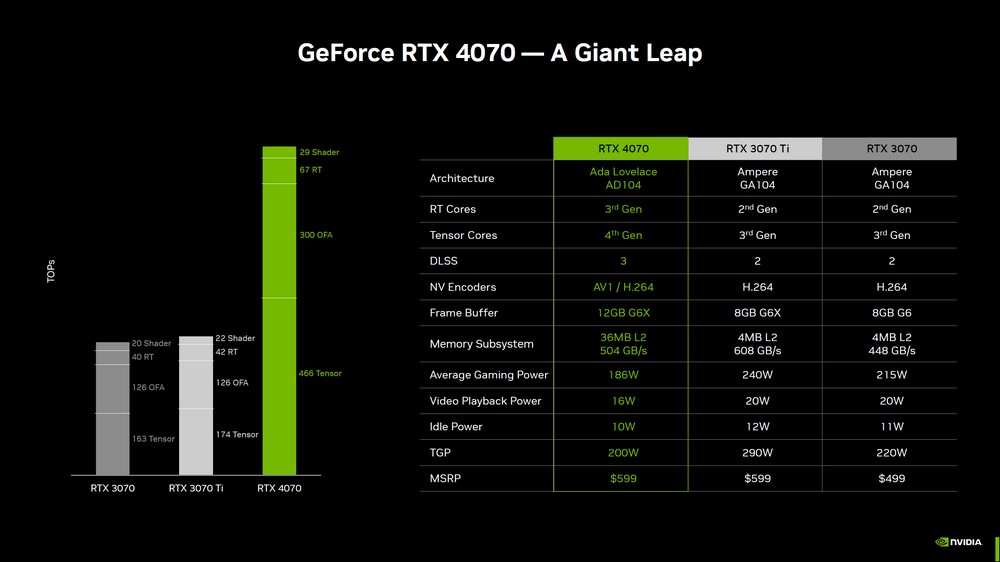
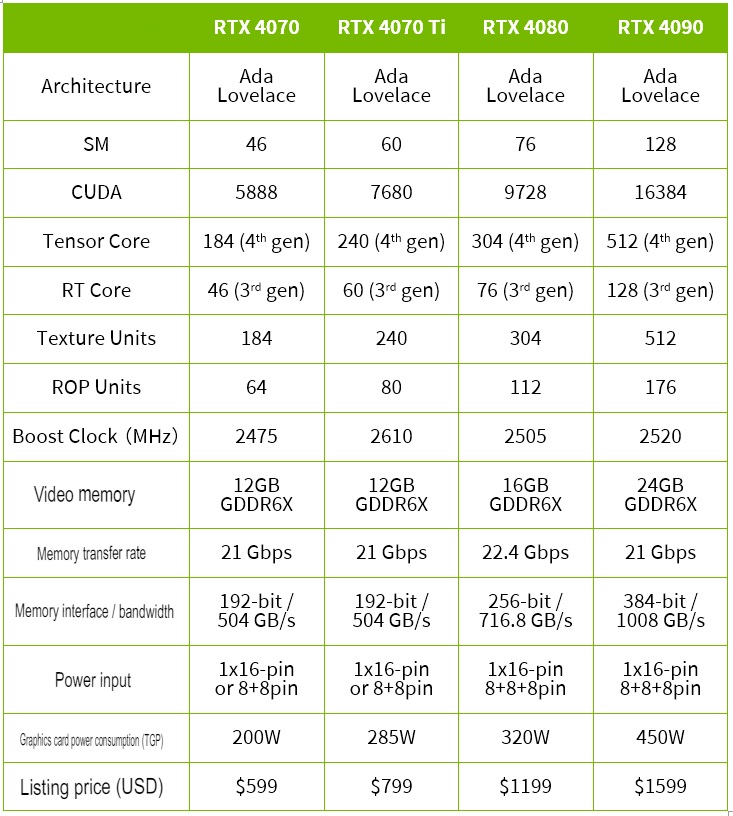
Regarding performance, the RTX 4070 exhibits a 20% improvement in general gaming performance compared to the RTX 3070 Ti. With DLSS 3 acceleration, this enhancement reaches up to 70%. The overall gaming performance of the RTX 4070 is on par with that of the RTX 3080. When compared to the RTX 2080, general gaming performance sees a 60% improvement, and with DLSS 3 acceleration, this can increase to 120%.
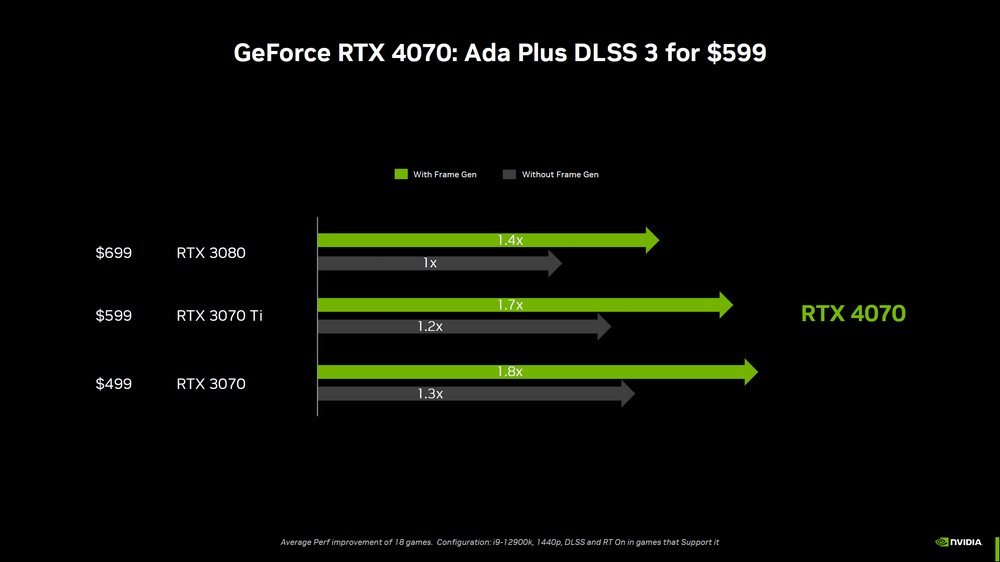
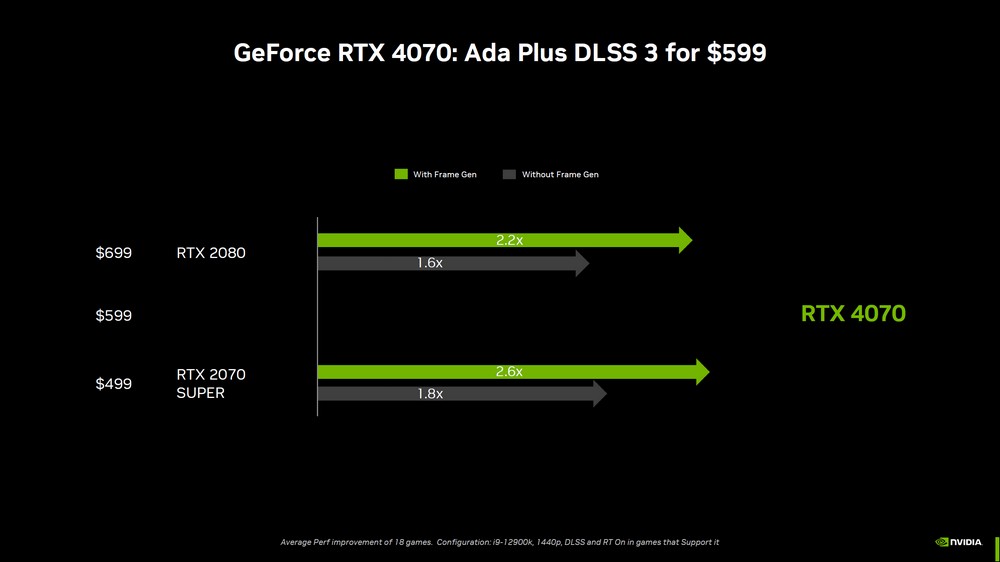
NVIDIA has announced the open-source release of RTX Remix Runtime, enabling modders to revamp older games by incorporating ray tracing and more realistic materials. Even Portal can be rejuvenated through RTX re-rendering. The Runtime will be made available on NVIDIA’s GitHub on April 12th, with the Creator Toolkit to be provided at a later date.
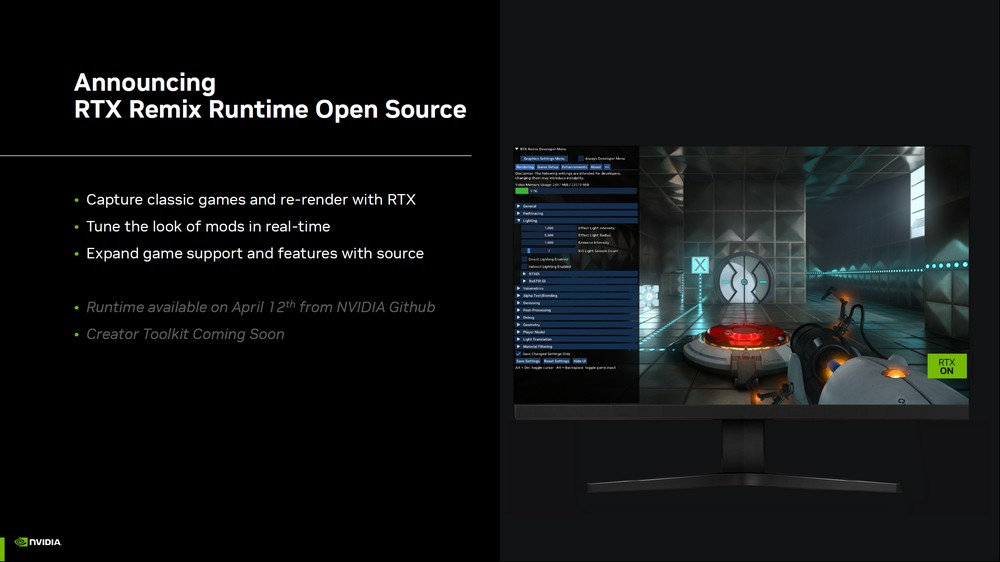
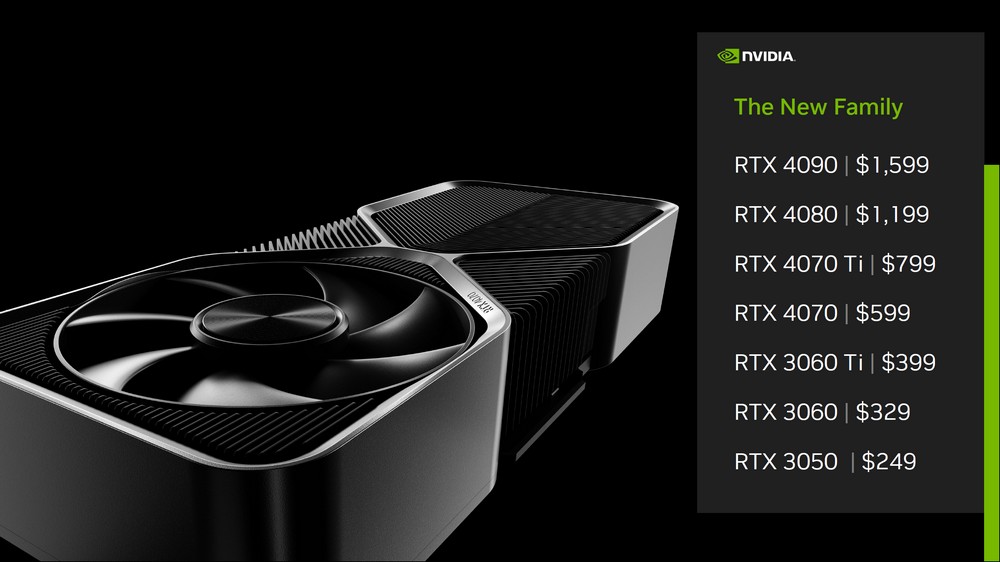
NVIDIA GeForce RTX 4070 Founder’s Edition Unboxing/Standard 24cm, 2-slot case-friendly card
The NVIDIA GeForce RTX 4070 Founder’s Edition reverts to a standard 24cm length and 2-slot installation space, making it more case-friendly. It retains the aluminum alloy X-Frame structure, which is filled with heat-dissipation fins. Internally, a vapor chamber helps dissipate heat from the GPU and VRAM, while heat pipes transfer waste heat to the cooling fins.
The card also features two 9cm fans for heat dissipation. The rear fan directs air through the fins and expels hot air out the back of the card, while the front fan draws in airflow from the front of the case, blowing it over the fins and fans and toward the top of the card. This design promotes better-cooling airflow within the case.
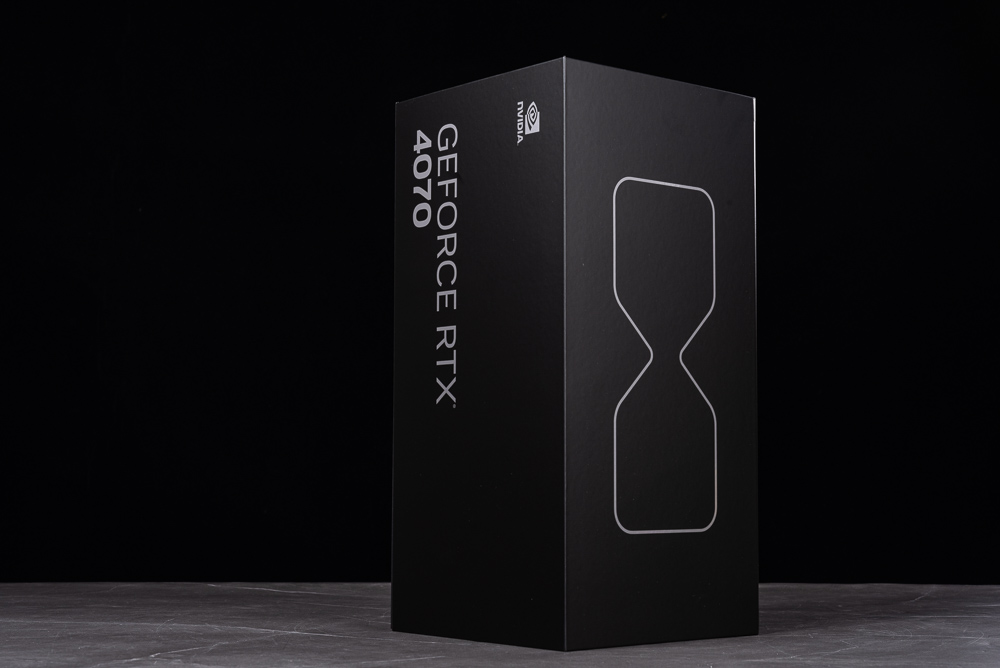
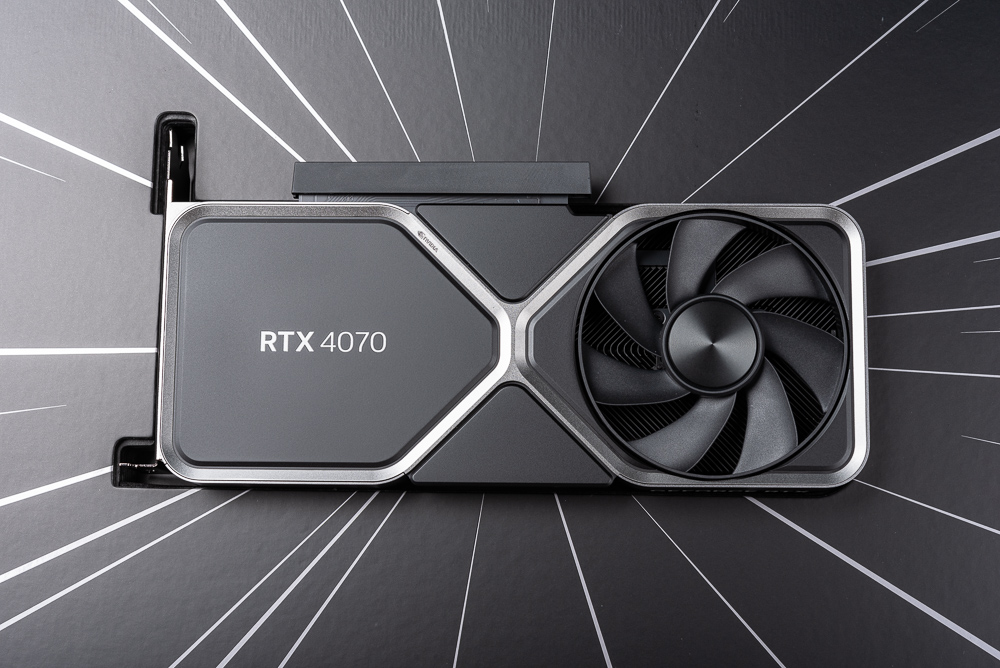
The RTX 4070 Founder’s Edition boasts an attractive design featuring a sleek and premium-quality aluminum alloy X-Frame structure. The back of the card displays the RTX 4070 lettering, while the front houses the exhaust fan configuration. On the other side, an abundance of cooling fins can be found, along with the air intake and heat dissipation mechanisms for the rear fan.
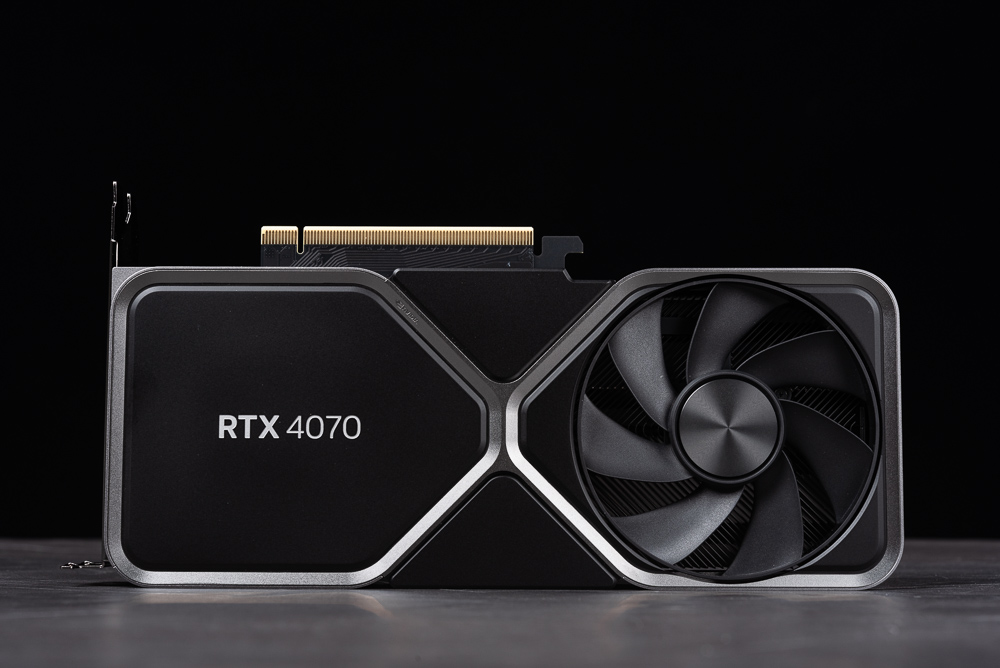
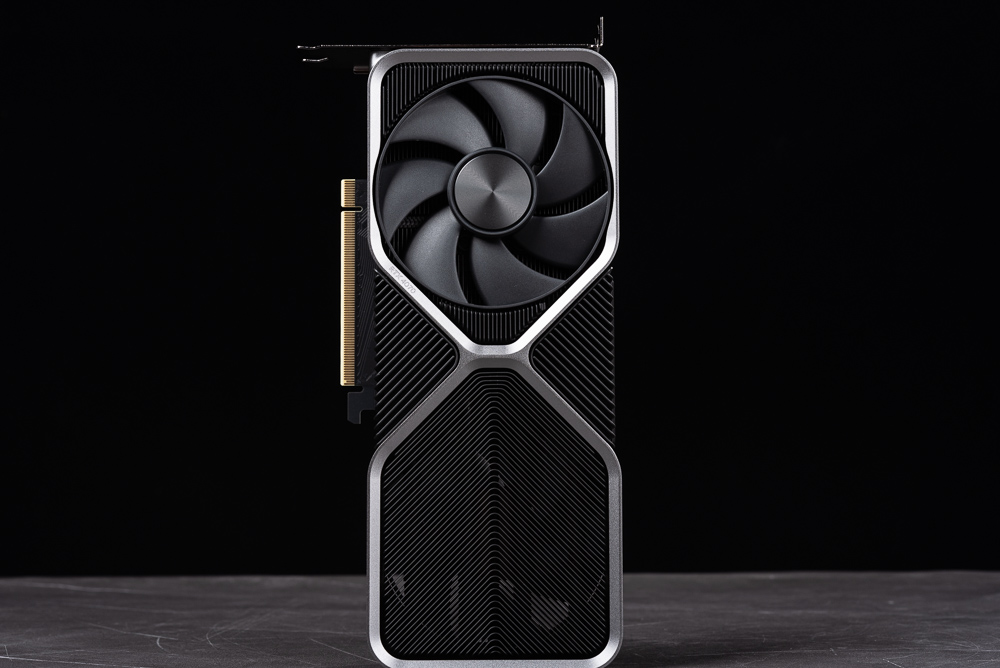
A PCIe 12+4 Pin (12VHPWR) power supply socket is located in the middle of the graphics card’s side. However, it has been reported that custom cards may also feature a traditional PCIe 6+2 Pin power supply design.
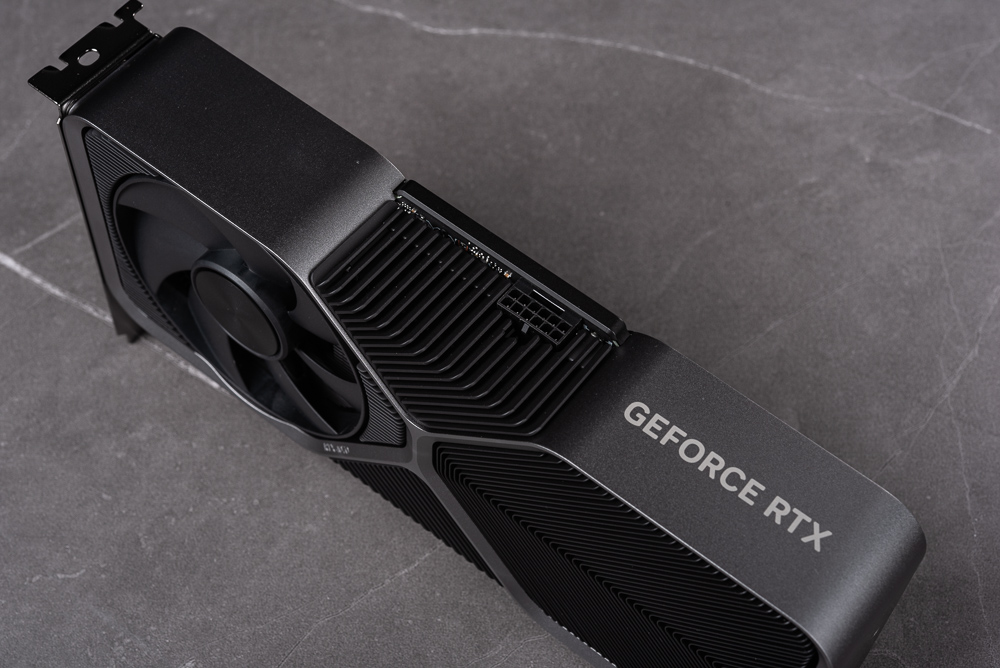
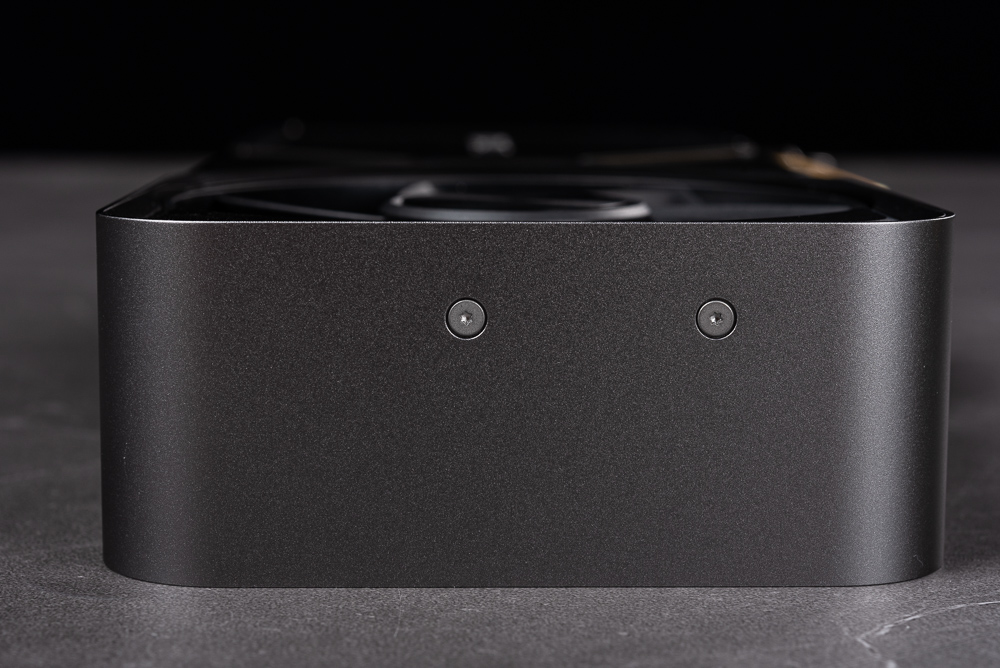
The display output includes HDMI 2.1a, which supports VRR, 4K120Hz / 8K60Hz HDR, as well as 3 DisplayPort 1.4a DSCs that support 12-bit 4K240Hz HDR / 12-bit 8K60Hz HDR and other output capabilities. The card can support up to 4 screen outputs simultaneously.
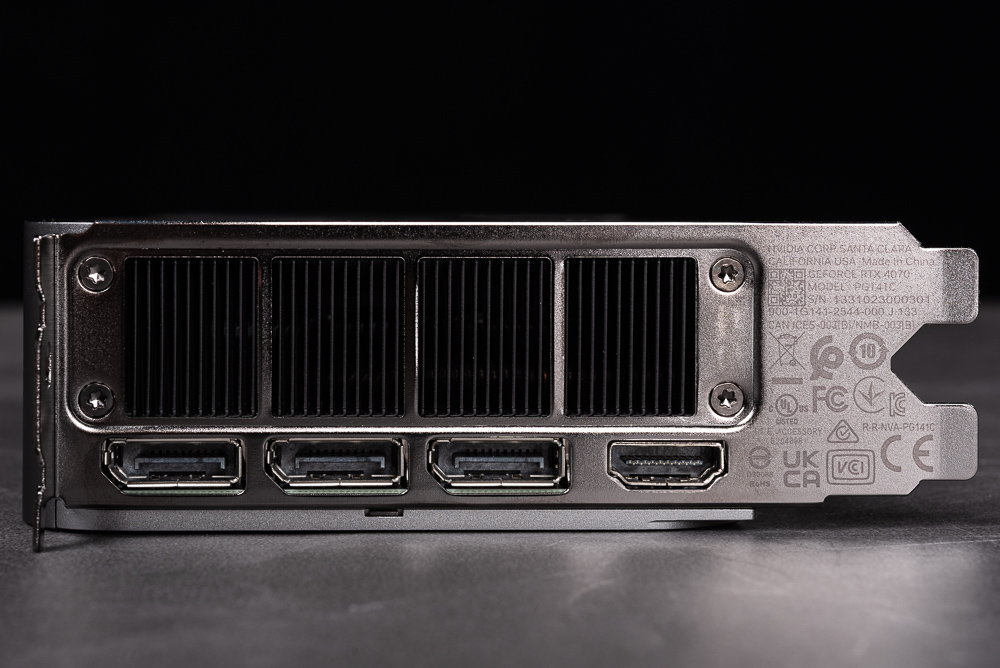
The accessories also include a PCIe 12+4 Pin (12VHPWR) adapter cable, which allows for the connection of two PCIe 6+2 Pin connectors.
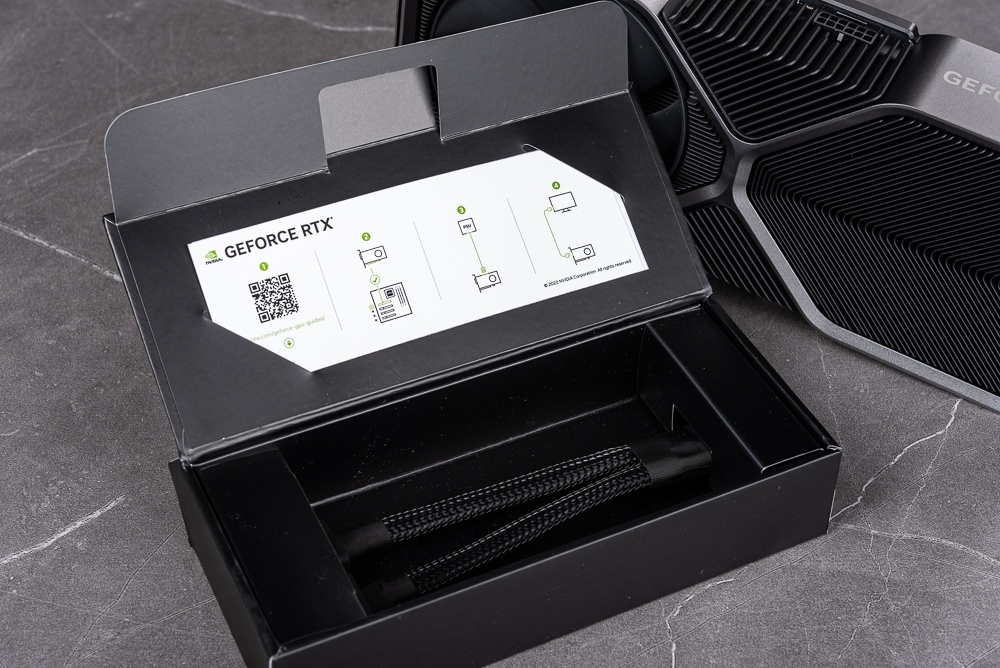
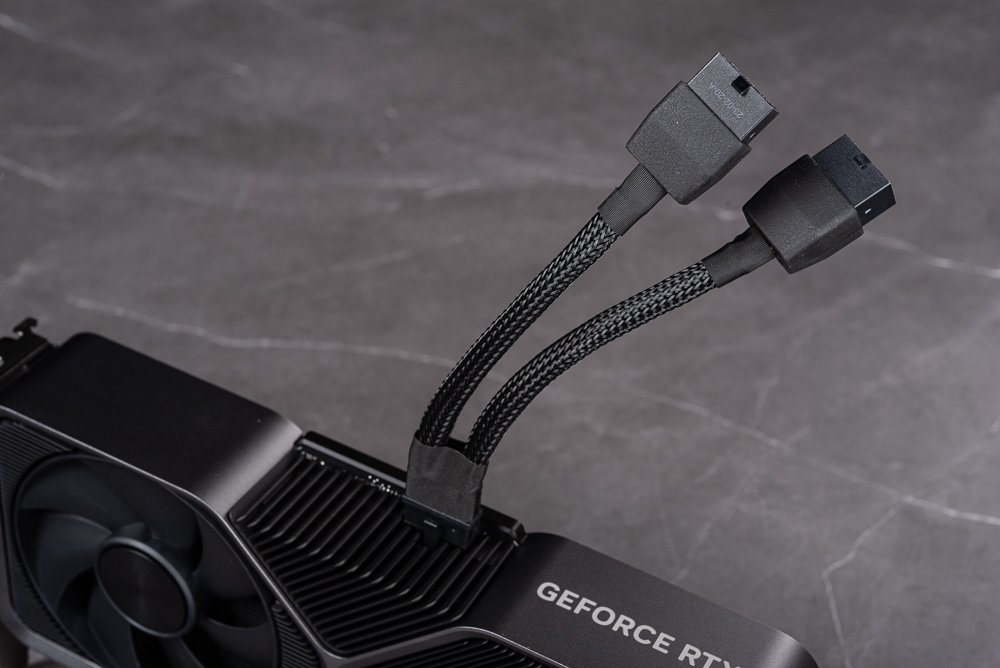
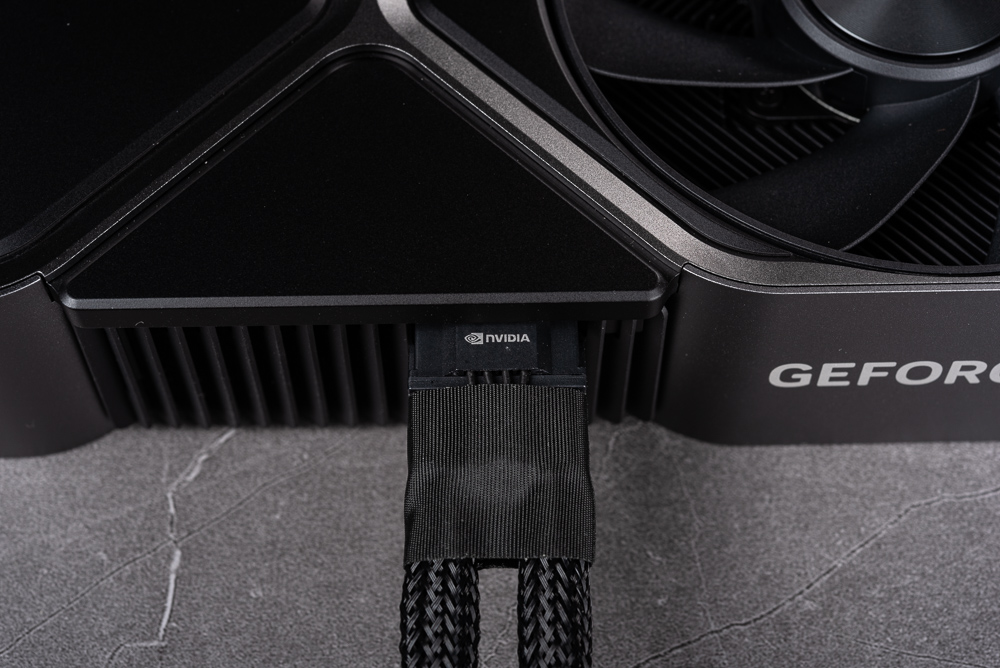
NVIDIA GeForce RTX 4070 Creation and Rendering Performance Test
This test encompasses creative benchmarks from DaVinci Resolve 18, Blender, Omniverse, and more. Gaming performance is assessed at 1440p and 1080p resolutions with maxed-out settings for esports, AAA titles, and ray-traced games, as well as DLSS 3-related tests. Both the RTX 4070 Ti and RTX 3070 Ti are compared to provide players with more data for reference.
Test Platform:
- Processor: Intel Core i9-13900K
- Motherboard: ASUS ROG MAXIMUS Z790 HERO
- Memory: KLEVV DDR5-7200 16GBx2
- Graphics Card: GIGABYTE GeForce RTX 4070 Ti EAGLE, NVIDIA GeForce RTX 4070, 3070 Ti Founder’s Edition
- System Disk: Solidigm P41 Plus 1TB PCIe 4.0 SSD
- Cooler: NZXT Kraken X73 360mm AIO Liquid Cooling
- Power Supply: Seasonic VERTEX GX-1000
- Operating System: Windows 11 Pro 21H2 64-bit, Resizable BAR On
- Driver Version: NVIDIA 531.42
Currently, GPU-Z is unable to display information about the NVIDIA GeForce RTX 4070. The AD104 GPU features a 4nm process with 5,888 rendering CUDA cores and 12,288 MB of GDDR6X (Micron) memory. The GPU’s base clock frequency is set at 1,920 MHz, while the Boost clock reaches 2,475 MHz.
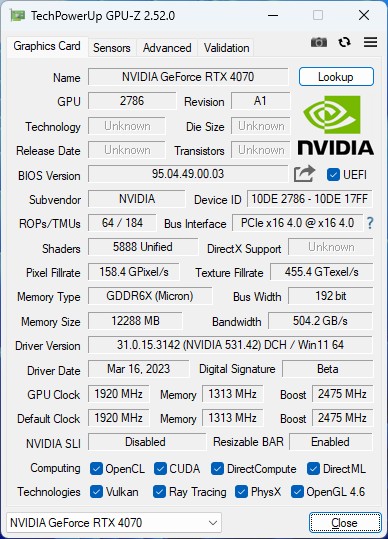
DaVinci Resolve 18 is a fully GPU-accelerated video editing software that offers robust color correction and visual effects capabilities. By utilizing CUDA core computation directly, it ensures smooth playback and efficient output of video clips, delivering exceptional performance.
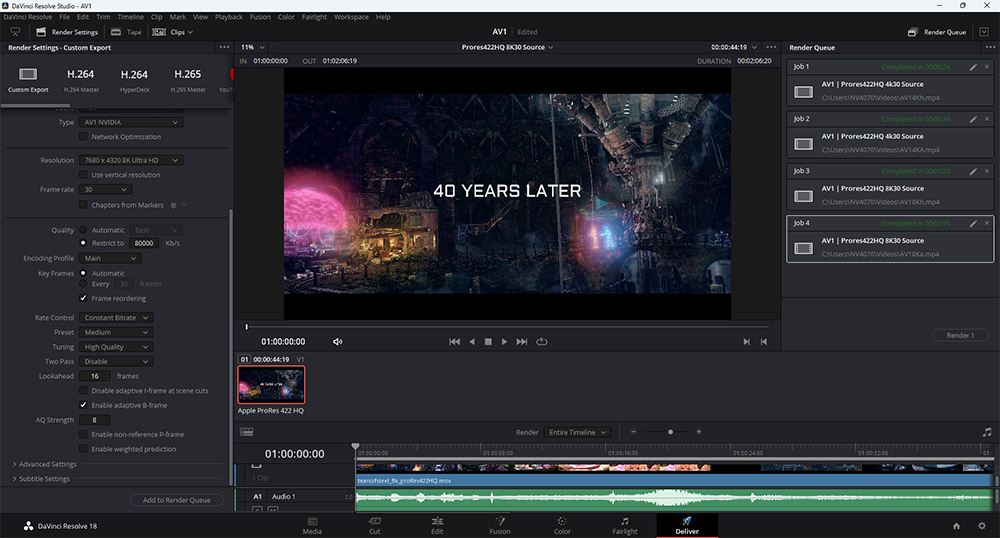
The first test project utilizes 4K Blackmagic RAW footage and features a Wedding_Heavy_Styles timeline. This video incorporates numerous Resolve effects, such as OFX: Light Rays, Glow, Sketch, and others, to create a highly stylized video.
Bride_FaceRefine_Selective_Color employs Face Refinement for face tracking and highlights the main bride with color. Both 50% Retime and Optical Flow Enhanced Better utilize Optical Flow technology to reduce the image speed by 50%.
SuperScale2x 4K Source uses a 4K ProRES source video to generate 4K video output with a 2x Zoom In subject. SuperScale4x HD_Source uses an HD H.264 source video and Resolve Super Scale to output 4K video.
Compared to the RTX 4070, the output time is not significantly behind that of the RTX 4070 Ti. However, audio and video users should consider the graphics card’s memory capacity and the size of their typical projects when selecting a card.
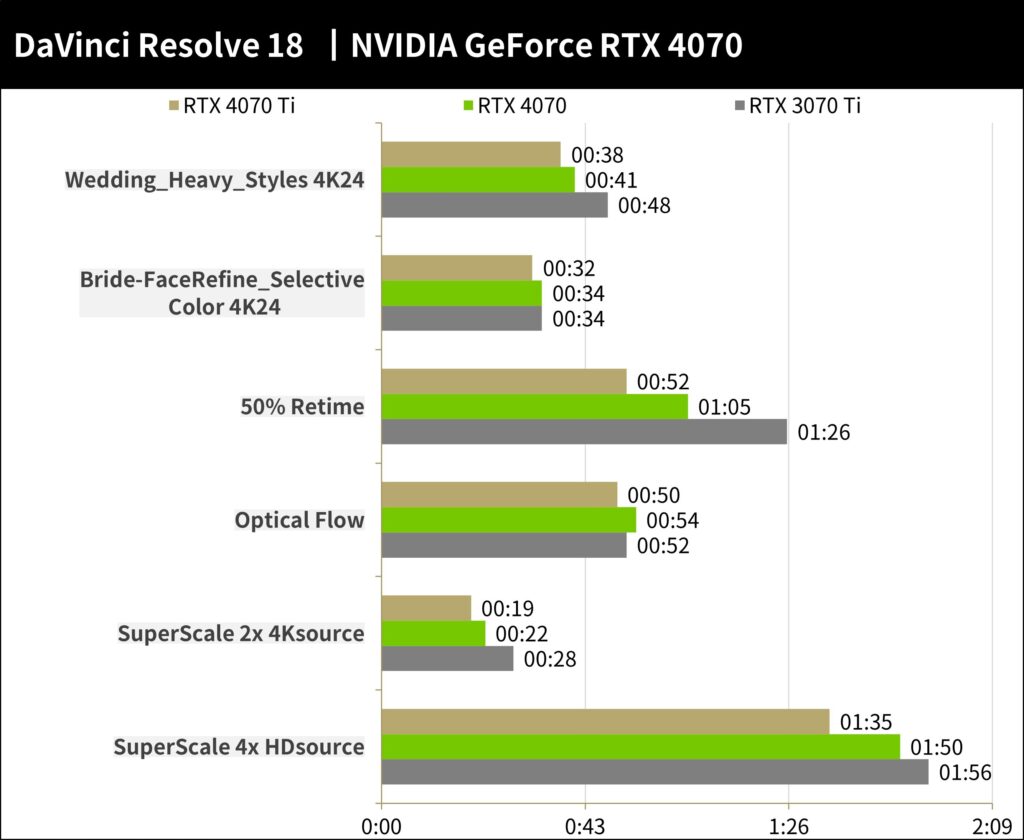
The second test involves AV1 and HEVC encoding using dual NVENC encoding. The test project is a 44-second short film from Blender’s Open Movie Project “Tears of Steel”, featuring 8K ProRes 442HQ 30FPS and 4K ProRes 422HQ 30FPS videos. This allows for testing of the HEVC and AV1 encoding output performance.
Output settings primarily use the NVIDIA Encoder with settings such as Quality: Restrict to 80,000 Kb/s, Encoding Profile: Main, Rate Control: Constant Bitrate, Preset: Faster, Tuning: High Quality, and Two Pass: Disabled.
In terms of performance, the RTX 4070 is only slightly slower than the RTX 4070 Ti when outputting 4K and 8K content. However, it is significantly faster than the previous generation RTX 3070 Ti.
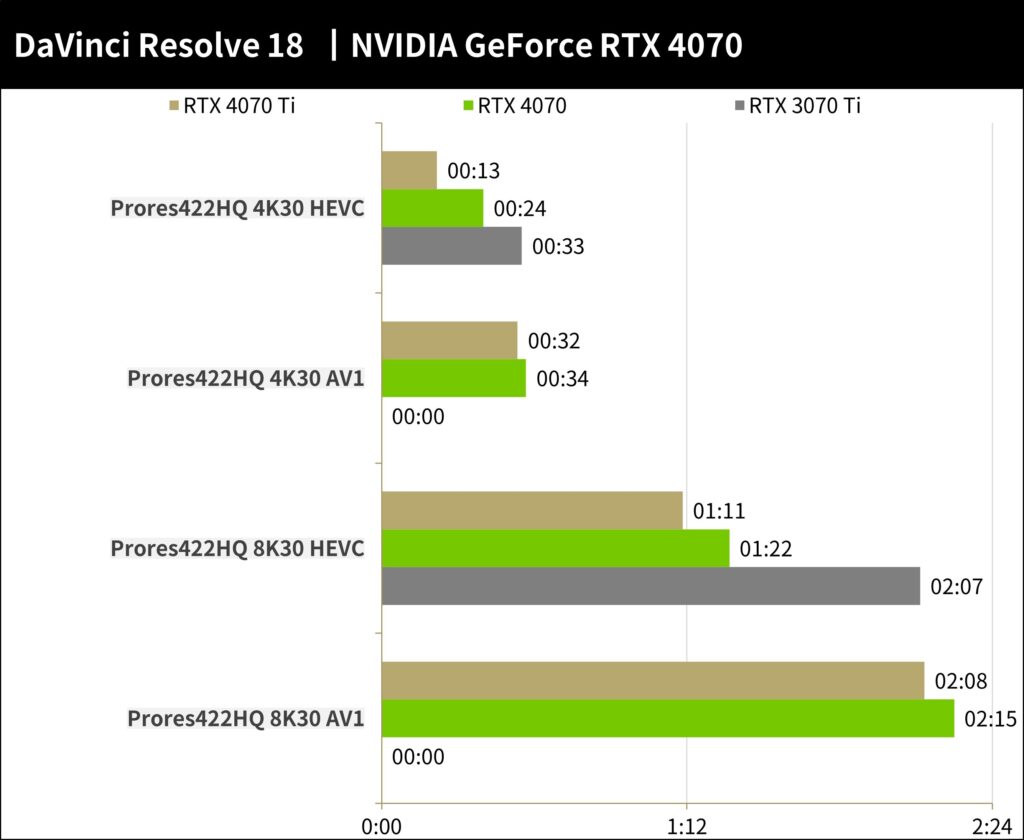
V-Ray Benchmark, developed by Chaos Group, is a ray-tracing rendering software based on the principles of physics. This tool can conduct calculation tests on ray-traced rendered images for both CPU and GPU.
According to the V-Ray test results, the RTX 4070 demonstrates a 23% performance improvement compared to the RTX 3070 Ti. However, its computing performance is 20% lower than that of the RTX 4070 Ti.
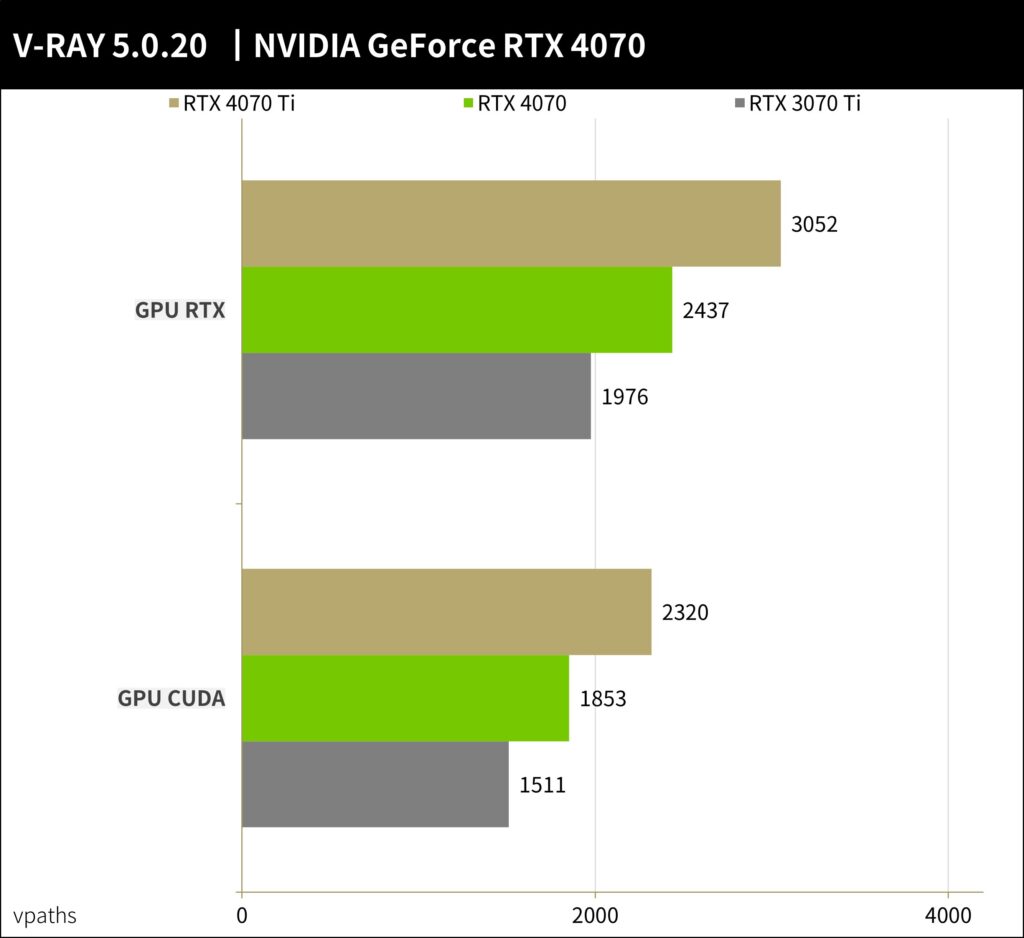
Blender is a cross-platform, open-source 3D creation tool that supports various 3D operations, including Modeling, Rigging, Animation, Simulation, Rendering, Compositing, and Motion Tracking. For testing, Blender Benchmark 3.3.0 is used to evaluate the rendering performance of the Demo project.
According to the Blender Benchmark 3.4.0 test results, the RTX 4070 demonstrates a 42% increase in computing performance compared to the RTX 3070 Ti. However, its computing performance is 18% lower than that of the RTX 4070 Ti.
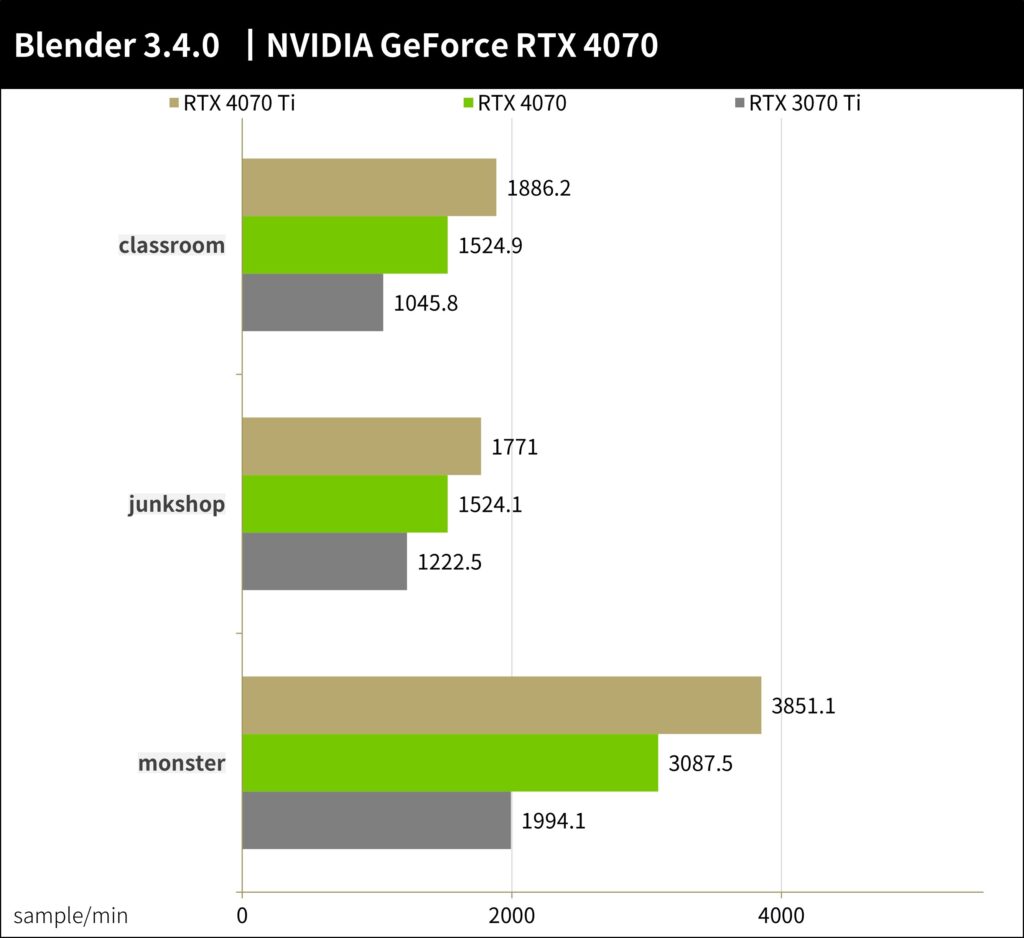
NVIDIA GeForce RTX 4070 Omniverse Creator Test
NVIDIA Omniverse is a collaborative platform designed to accelerate 3D design. It not only seamlessly integrates with mainstream 3D applications in the industry, but also enables creators from around the world to work simultaneously on 3D projects and obtain real-time rendering effects. It also offers functionalities such as Digital Twin and robot training simulations.
This test primarily uses the Omniverse Create project to perform real-time ray tracing rendering and DLSS 3 accelerated FPS performance testing. The test projects include:
- Campfire_Main_03_Flow3: Simulates the physical effects of a campfire burning.
- Flowers4: Tests instanced geometry and particle flow animation.
- Incense_Main: Examines smoke simulation and reflective material changes.
- JadeTiger: A test scene containing a detailed model with advanced jade materials.
- Warehouse_Physics_Stage: A test scene simulating the domino effect of collapsing warehouse shelves.
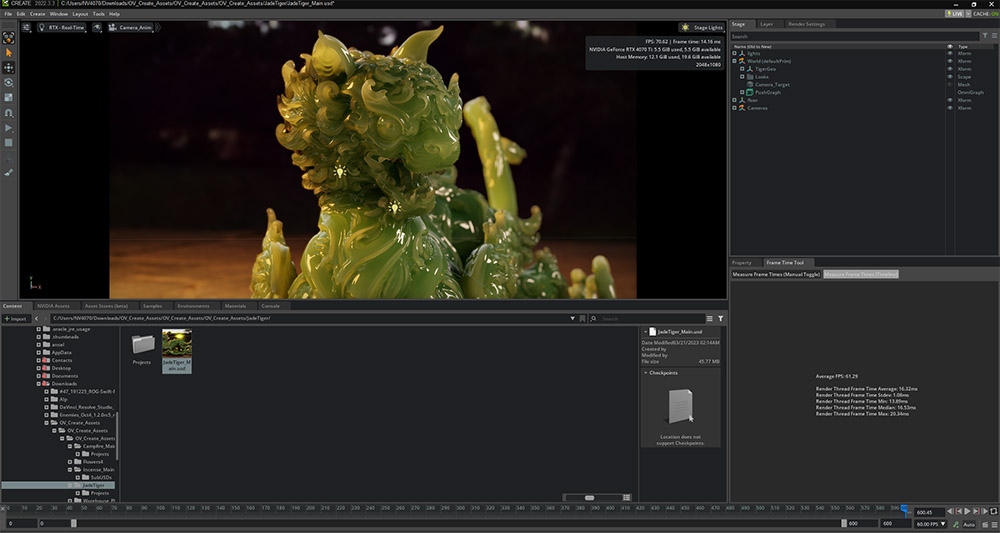
Under the QHD ViewPort and DLSS3 Quality settings, the RTX 4070 can achieve an average rendering performance of approximately 50 FPS. It boasts an average performance lead of 139% over the RTX 3070 Ti but lags behind the RTX 4070 Ti by an average of 20% in terms of performance.
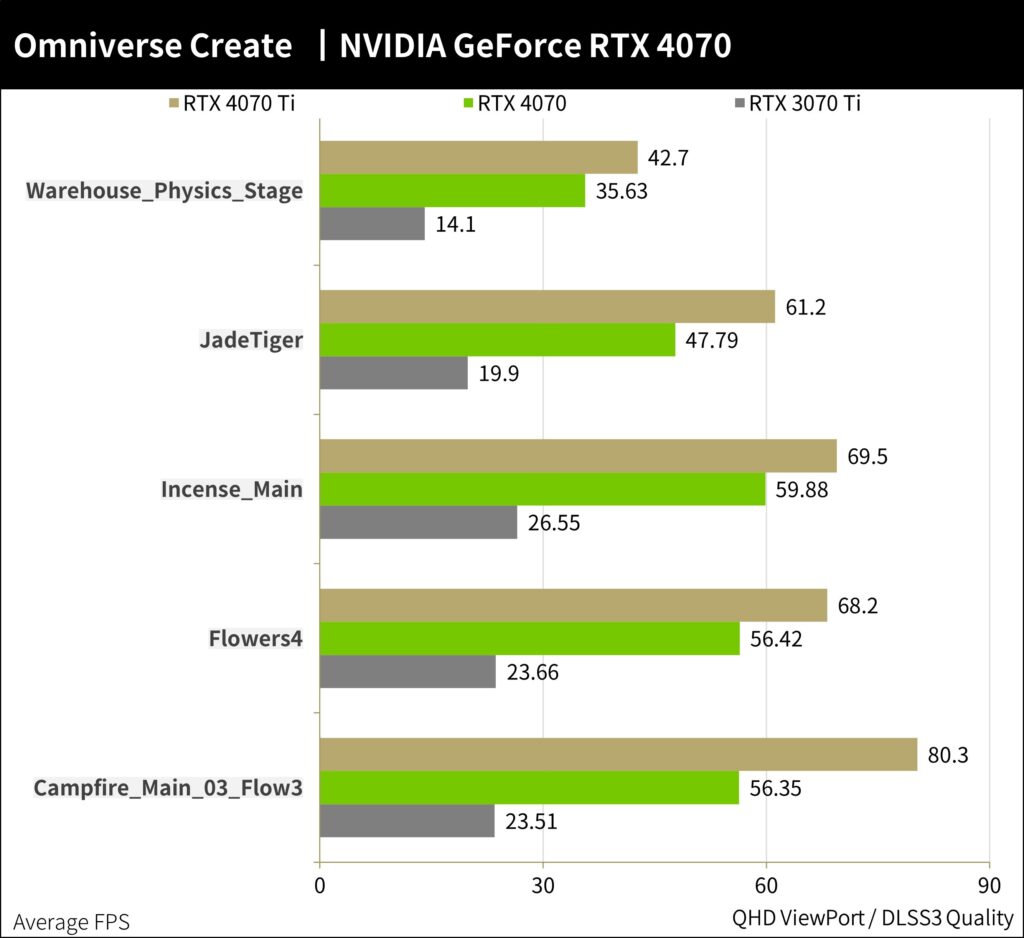
NVIDIA GeForce RTX 4070 AI image calculation Stable Diffusion test
Stable Diffusion is a popular AI deep-learning text-to-image generation model. The version released by Automatic1111 Web UI has been manually installed with the latest cuDNN DLLs, enabling Stable Diffusion to achieve the best GPU acceleration performance. This version was used to compare the AI computing capabilities of GPUs.
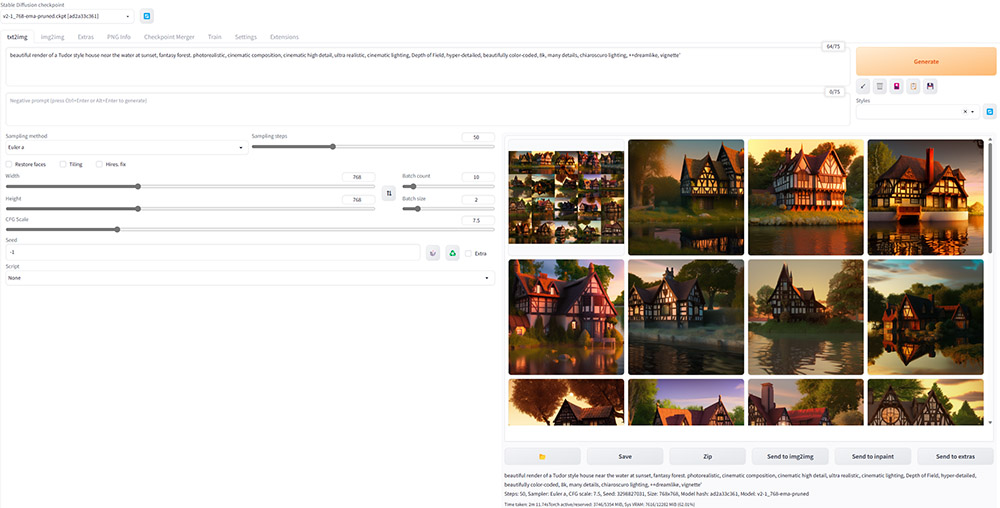
The test settings and parameters are described below the picture. According to the test results, the RTX 4070 has a picture generation speed of 9.16 pictures per minute. It outperforms the RTX 3070 Ti by 28% in terms of performance but lags behind the RTX 4070 Ti by -18%.
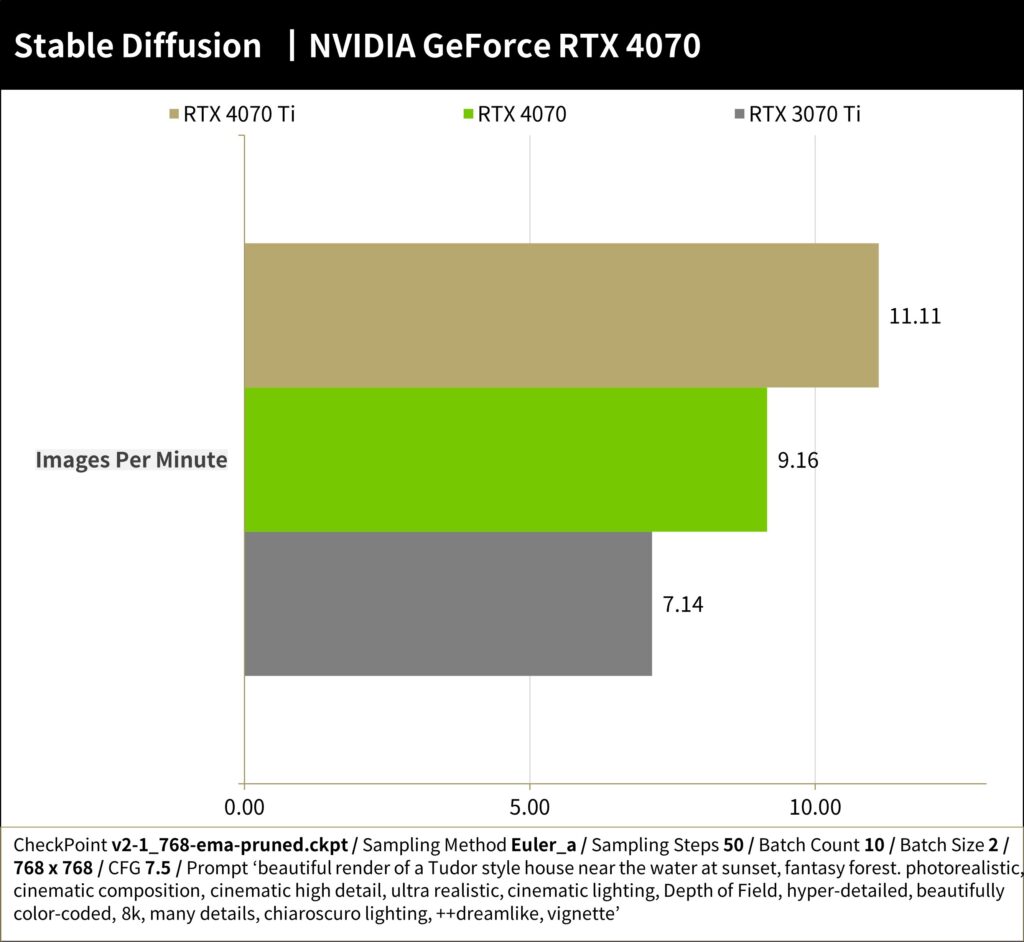
NVIDIA GeForce RTX 4070 – 3DMark Benchmark Performance Test
The 3DMark Fire Strike performance test is designed to test the performance of the mainstream DirectX 11 API at different resolutions, including 1080p, Extreme 1440p, and Ultra 2160p.
The RTX 4070 achieved a score of 36606 points in Fire Strike, 21471 points in Extreme, and 10616 points in Ultra. These results show an average improvement of 17% in graphics performance compared to the RTX 3070 Ti but a slightly lower performance compared to the RTX 4070 Ti, with a gap of about -20%.
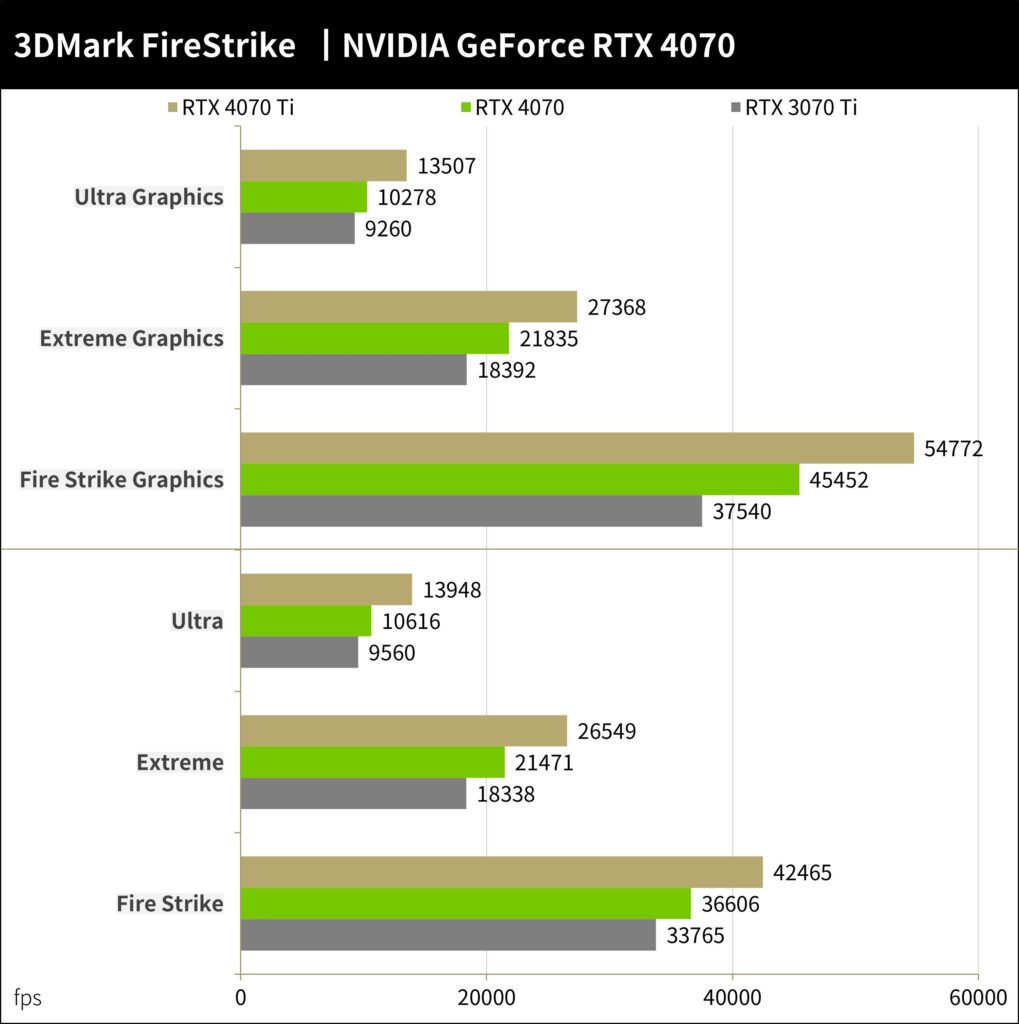
The 3DMark Time Spy is a benchmark test that uses the DirectX 12 API and is calibrated to the level of a high-quality AAA game to evaluate the performance of graphics cards at 1440p and 2160p resolutions. In Time Spy, the RTX 4070 scored a total of 18588 points, and 9203 points in Extreme. This represents a 20% increase in performance compared to the RTX 3070 Ti but falls short by approximately 21% compared to the RTX 4070 Ti.
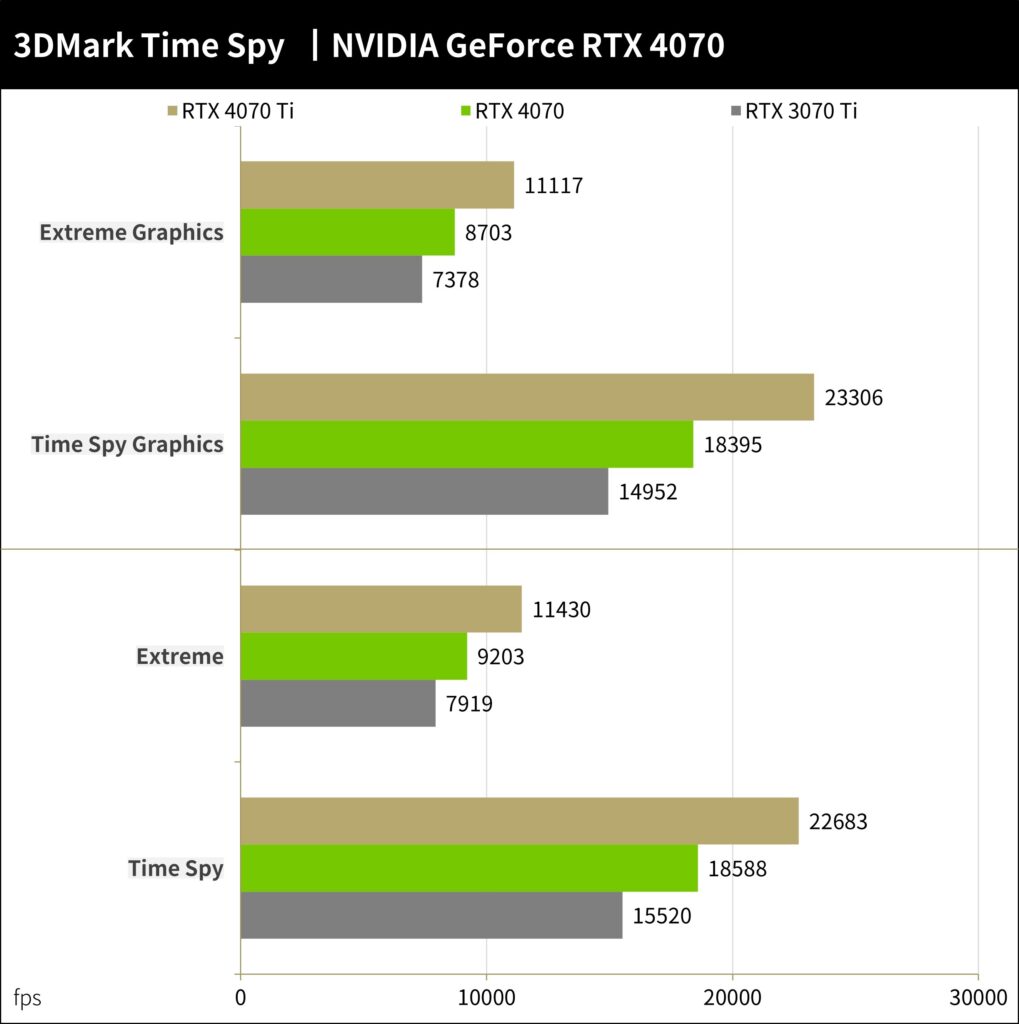
3DMark Port Royal is a ray tracing benchmark that incorporates ray tracing features into scenes from AAA games, testing the hardware acceleration capabilities of new-generation GPUs. The DXR test, on the other hand, is a functional test that uses the DirectX Raytracing API, while Speed Way is a test scenario developed using full ray tracing.
Without DLSS, the RTX 4070 achieved a frame rate of 52.47 FPS in Port Royal, 52 FPS in DXR, and 45.39 FPS in Speed Way. This represents a 35% increase in ray tracing performance compared to the RTX 3070 Ti but still falls behind the RTX 4070 Ti by approximately 21%.
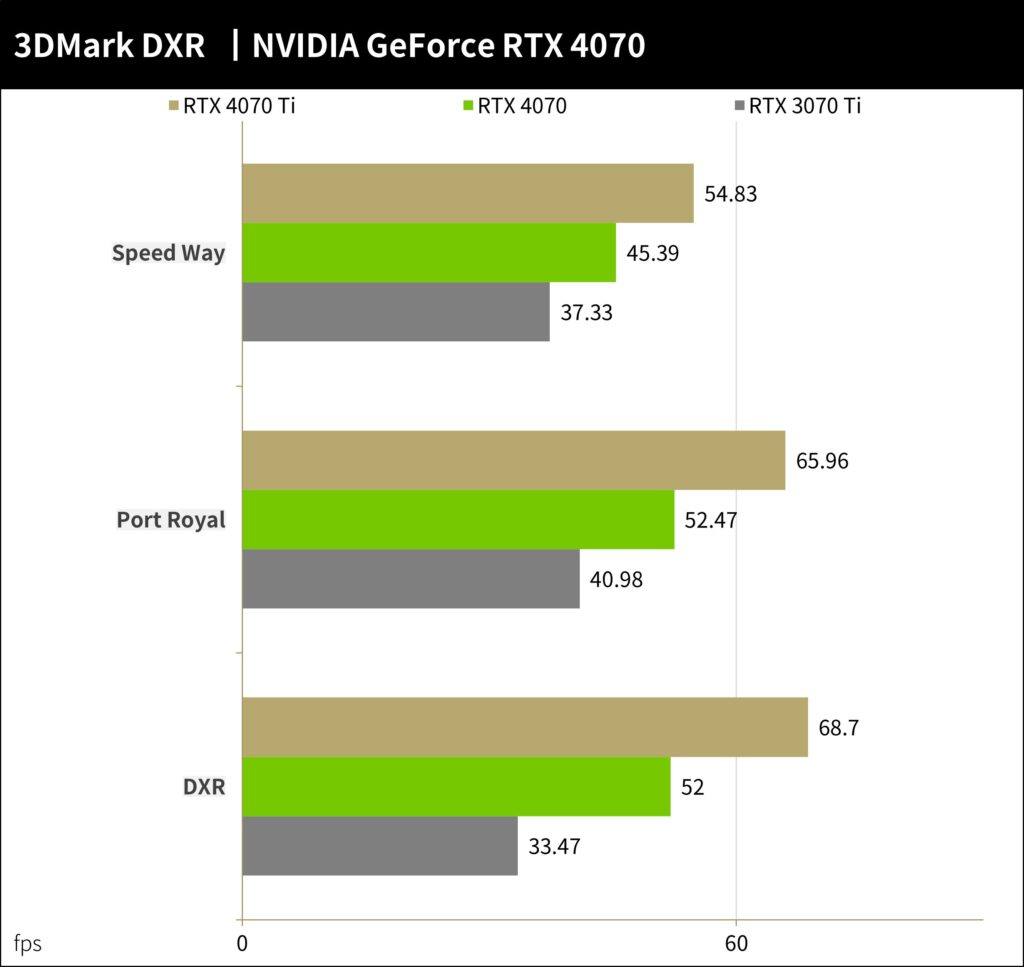
The 3DMark DLSS Feature Test is used to evaluate the performance of DLSS 3 and DLSS 2, with performance-boosting settings set to 3840 x 2160 resolution.
The RTX 4070 can achieve a frame rate of 65.05 FPS in DLSS 2, resulting in a performance improvement of approximately 2.7 times. In DLSS 3, which utilizes AI-based frame interpolation technology, the RTX 4070 can achieve a frame rate of 108.6 FPS, resulting in a performance improvement of about 4.6 times.
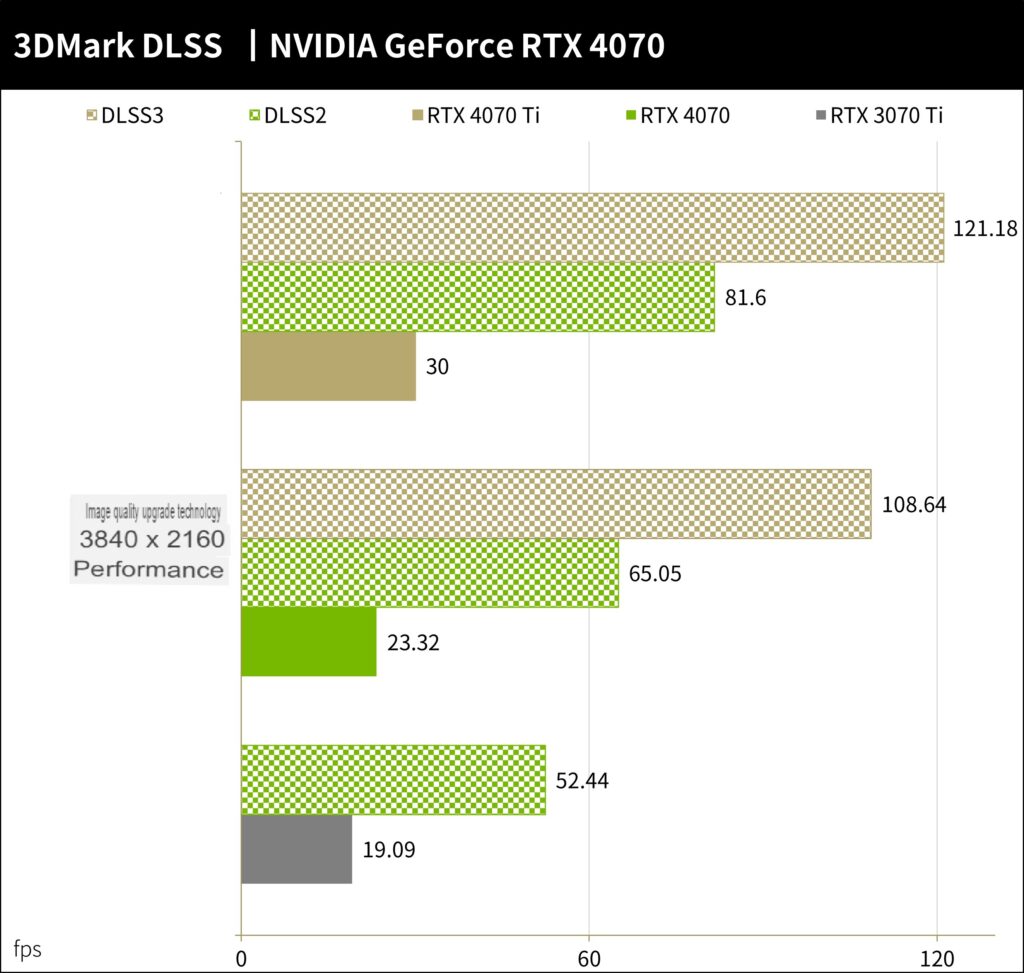
NVIDIA GeForce RTX 4070 – 4 e-sports games performance test
The e-sports games “Rainbow Six: Siege,” “League of Legends,” “APEX Heroes,” and “CS:GO” are all tactical competitive shooting and DOTA-type games that require skill and teamwork. As such, even with lower game quality and details, a game FPS of over 100 frames on average is achievable. Tests were conducted at 2160p and 1440p resolutions, with the highest special effects setting.
The performance of the RTX 4070 is powerful enough to meet the demands of e-sports players at 1440p and above 200 FPS. Compared to the RTX 3070 Ti, the RTX 4070 has an average 9% lead at 2K resolution but falls behind the RTX 4070 Ti by approximately 12%.
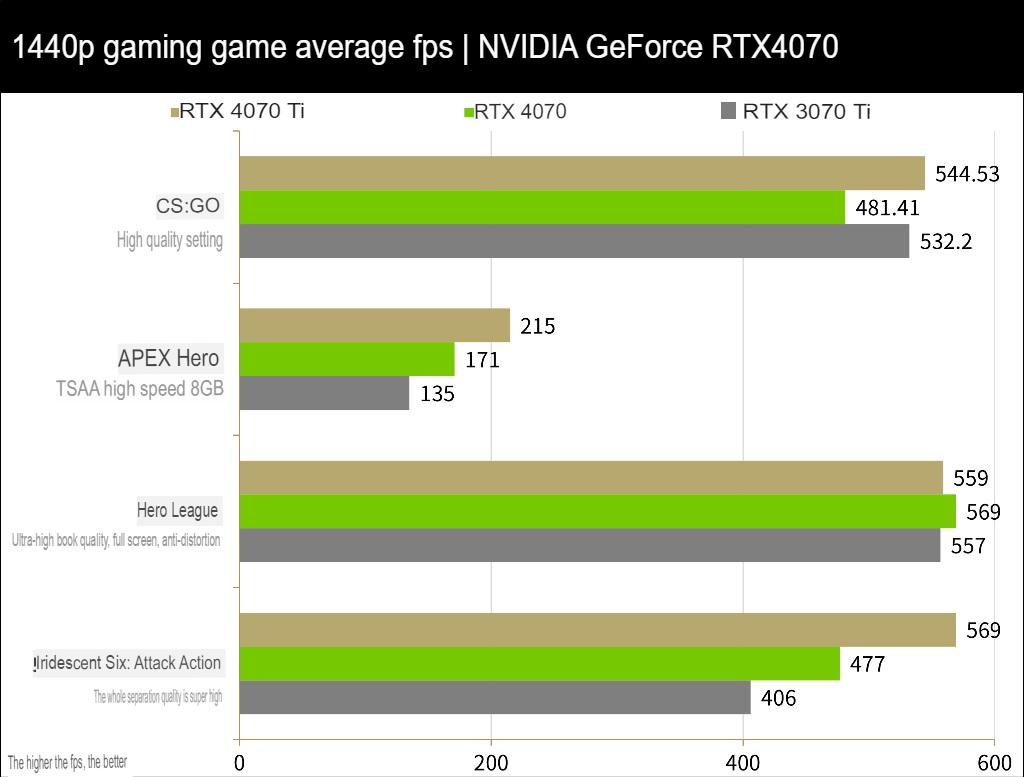
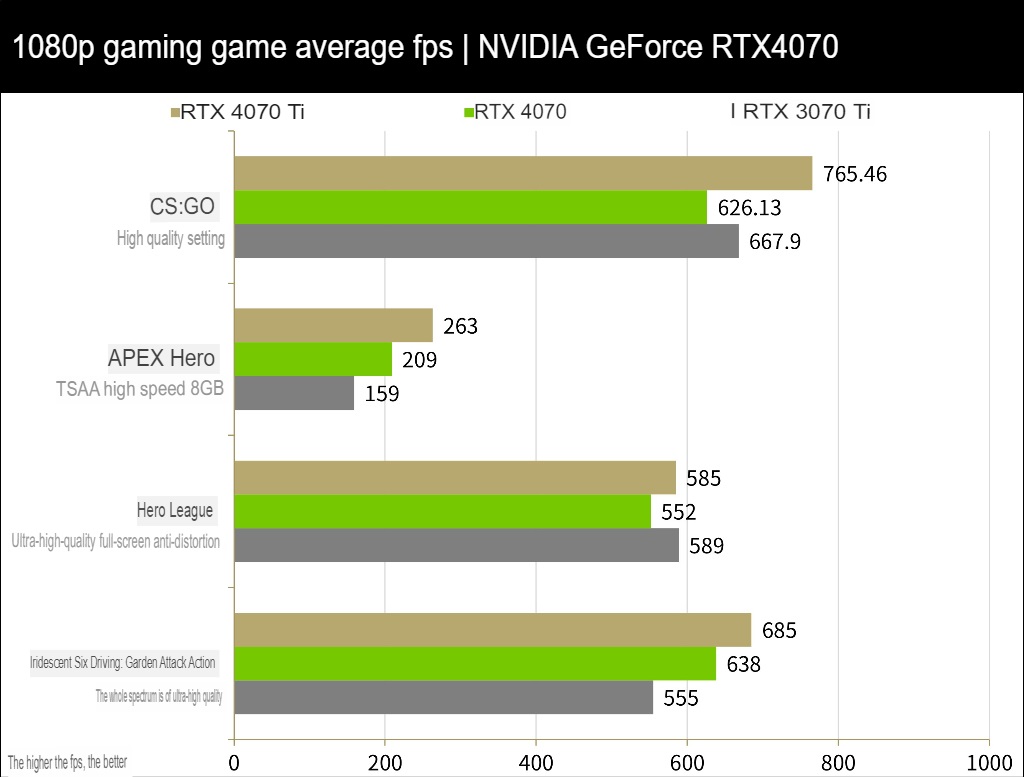
NVIDIA GeForce RTX 4070 – 11 games performance test
The test measured the average performance of 11 AAA games at 1440p and 1080p with fully open special effects. Among them, only F1 2021 uses ray tracing, and there is no DLSS acceleration. The test evaluates the GPU’s performance in traditional rendering games.
The list of games tested includes entry-level “F1 2021,” “Forspoken,” “Tomb Raider: Shadow,” movie games “Death Stranding,” “Gears of War 5,” “The Division 2,” “Horizon: Waiting for Dawn,” as well as tests such as “Borderland 3,” “Assassin’s Creed: Viking Age,” “Blood Killing 2,” and “God of War,” which are performance-intensive.
The RTX 4070 achieved an average of 118.2 FPS in 1440p AAA games. Compared to the average 100 FPS of the RTX 3070 Ti, it represents an 18% performance upgrade. However, it falls slightly behind the RTX 4070 Ti by approximately 17% in-game performance.
At 1080p resolution, the RTX 4070 averages 158.35 FPS, representing a 20% performance upgrade compared to the RTX 3070 Ti, but it still lags behind the RTX 4070 Ti by about 14%.
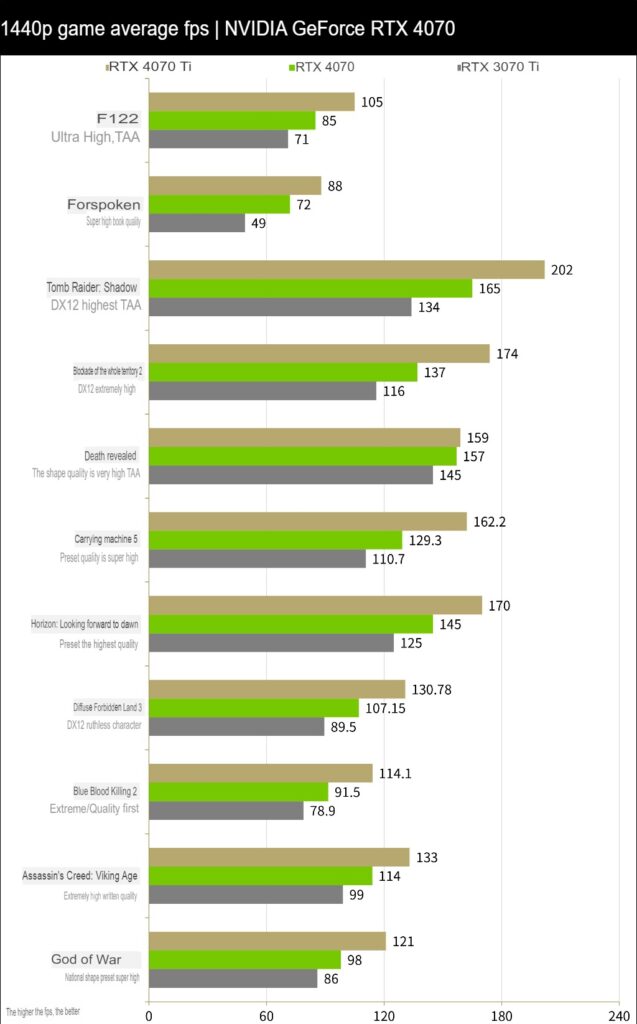
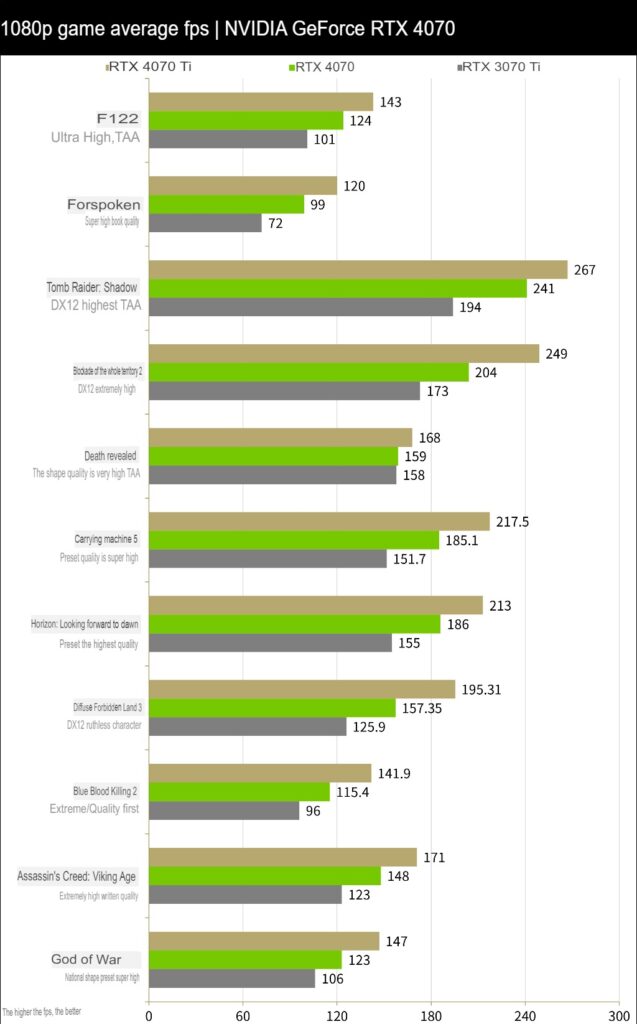
NVIDIA GeForce RTX 4070 – 10 ray-chasing game tests
The test includes 10 DXR ray tracing game tests, as well as “The Witcher 3: Wild Hunt” with ray tracing and DLSS support, “Portal with RTX” light-chasing version modded by NVIDIA, and games such as “Cyberpunk 2077,” “Control,” “Watch Dogs: Legion of Freedom,” “Deep Rock Galactic,” “Spider-Man: Miles Moras,” “Marvel’s Avengers,” and “Far Cry 6.”
Although “Microsoft Flight Simulator” does not support ray tracing, it enables DLSS 3 acceleration, so it is also included in the test. The test is conducted at 1440p and 1080p resolutions, with the highest settings for special effects/ray tracing and DLSS acceleration enabled. Detailed settings can be found in the chart description.
At 1440p resolution with DLSS 3 acceleration, the RTX 4070 achieved an average of 106 FPS in “The Witcher 3: Wild Hunt,” 88 FPS in “Portal with RTX,” and 98 FPS in “Cyberpunk 2077.” The 10 ray tracing games reached an average of 115.2 FPS.
Compared to the RTX 3070 Ti, the RTX 4070 has a 42% performance upgrade in ray tracing games but falls approximately 17% behind the RTX 4070 Ti in ray tracing game performance.
At 1080p resolution, the RTX 4070 averages 144.5 FPS, representing a 41% performance upgrade compared to the RTX 3070 Ti, but falls behind the RTX 4070 Ti by approximately 13% in-game performance.
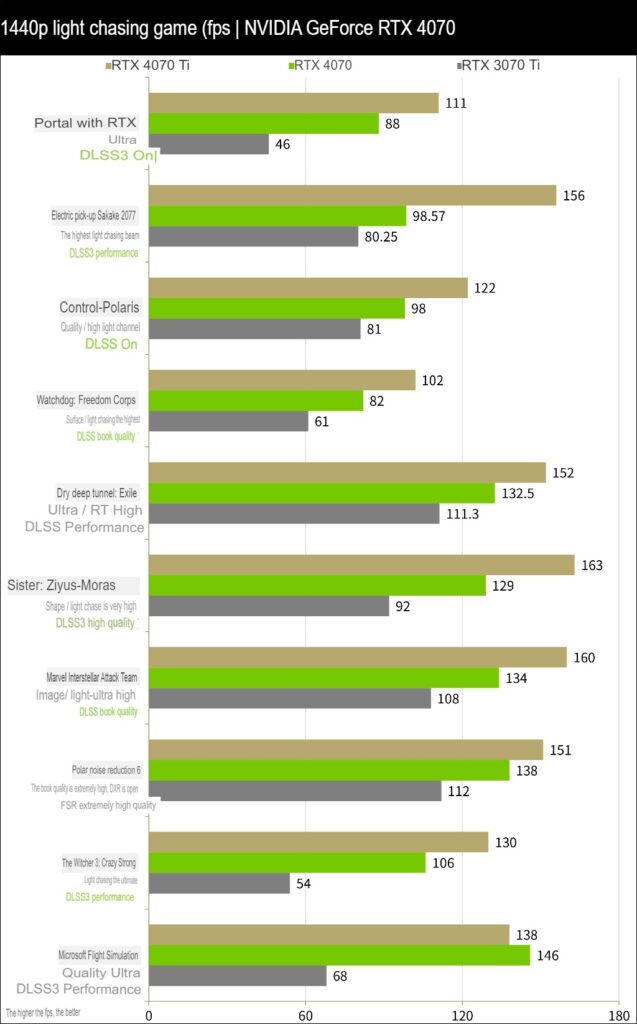
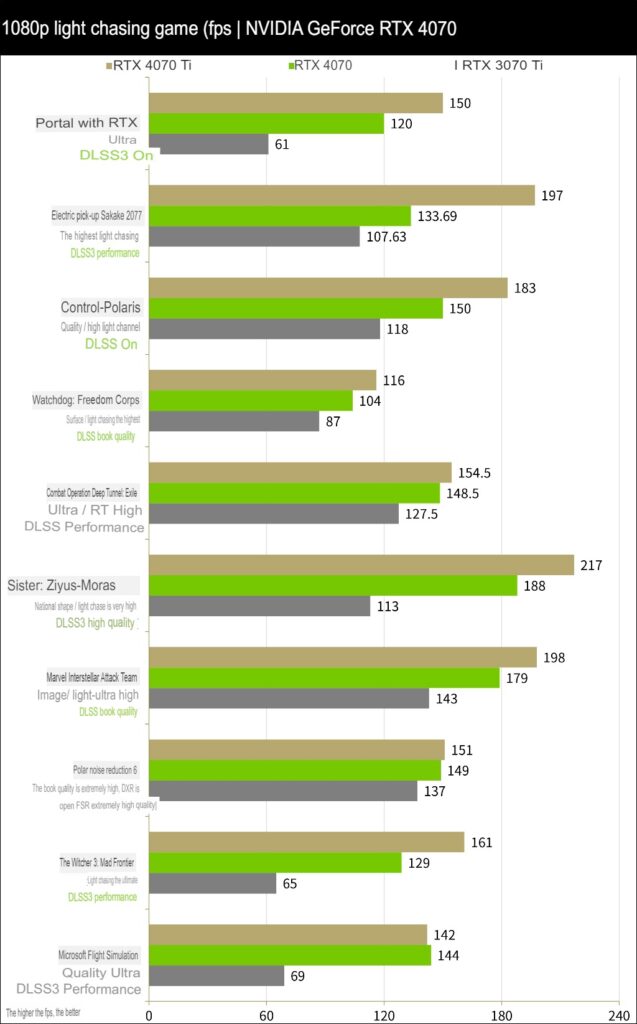
NVIDIA GeForce RTX 4070 power consumption and temperature measurement
The power consumption and temperature of the graphics card were tested using the Time Spy Stress Test, Furmark, and “Cyberpunk 2077.” To measure power consumption, the PACT tool provided by NVIDIA was used to monitor the wattage provided by the PCIe slot and the power supply 12V.
In terms of graphics card temperature, the RTX 4070 Founder’s Edition maintained a maximum temperature of 64.1°C during the stress test, while the temperature during “Cyberpunk 2077” was slightly lower at 61°C. Compared to the previous generation RTX 3070 Ti’s 76°C, the smaller size of this generation’s Founder’s Edition, coupled with the efforts of the TSMC process and NVIDIA, has resulted in quite impressive temperature performance.
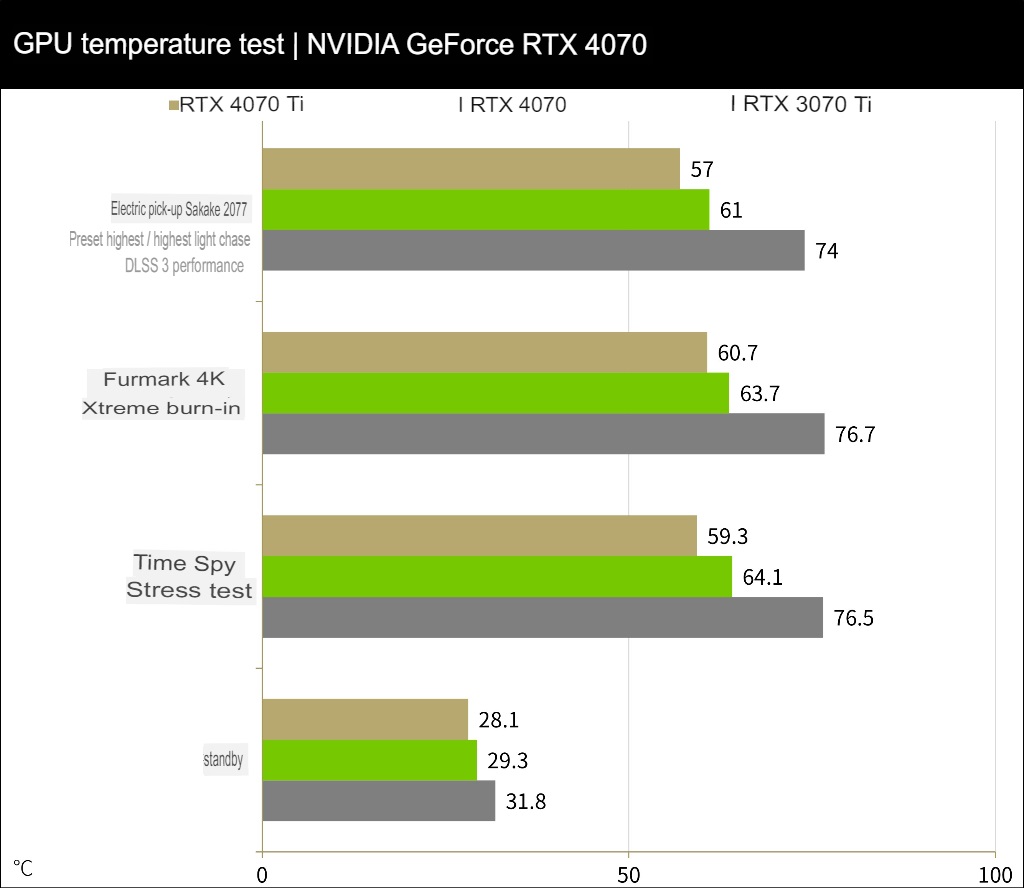
During the TBP power consumption test of the graphics card, the RTX 4070 Founder’s Edition reached an average power consumption of 197.3W during the Time Spy Stress Test. The Furmark 4K Xtreme burn-in test resulted in maximum power consumption of 200W, while “Cyberpunk 2077” only consumed 196.2W during gameplay. The RTX 3070 Ti’s power consumption of 258W can only be attributed to the unstoppable combination of TSMC and NVIDIA.
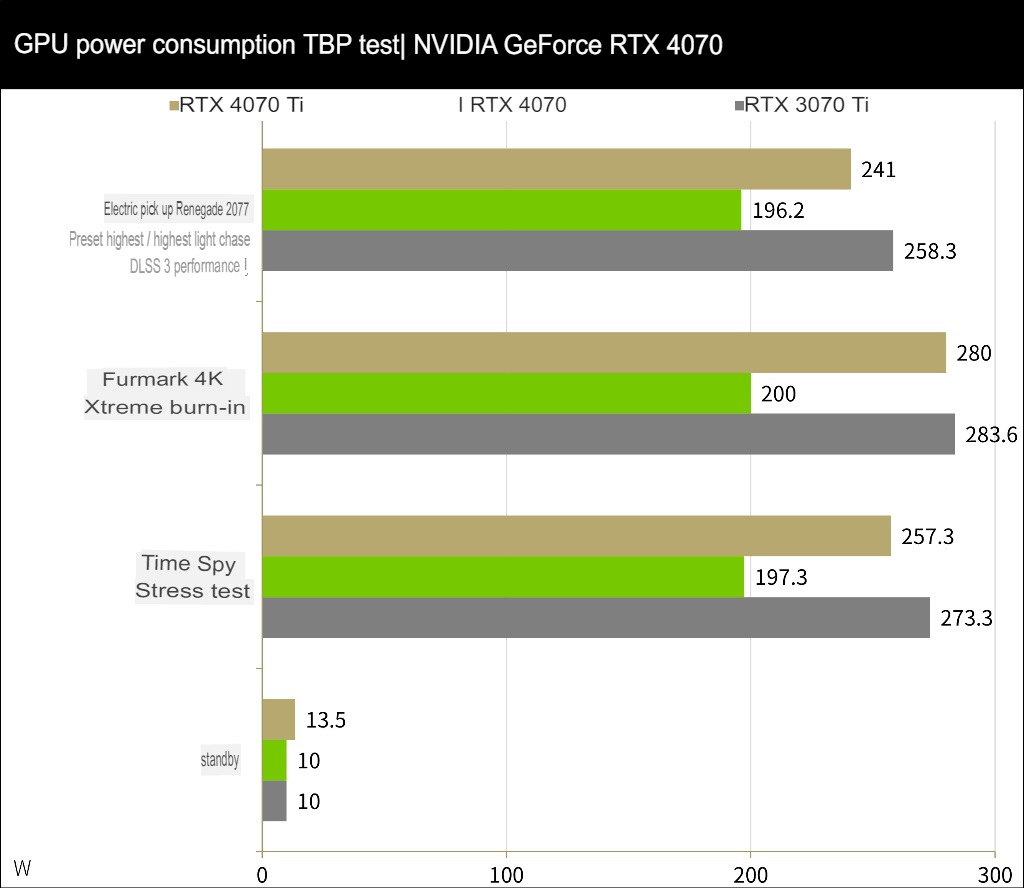
Summary
The NVIDIA GeForce RTX 4070 meets the performance needs of 2K gamers, with an average game performance of 118.2 FPS in 11 AAA games and an average game performance of 115.2 FPS in 10 light-chasing games. Compared to the previous generation RTX 3070 Ti at the same price, it provides an 18% performance improvement and a 41% performance upgrade for Ray Tracing DLSS 3 games.
Although the RTX 4070 falls behind the RTX 4070 Ti by about 20% in terms of creative and gaming performance, it still provides a better value proposition with its 12GB GDDR6X memory, a US price of $599, and a recommended price of 20,990 Taiwanese dollars. This makes it an excellent choice for gamers with a graphics card budget of around 20,000, providing better 2K gaming and creative performance upgrades.
As the market for NVIDIA graphics cards has almost emptied the original RTX 3070 Ti graphics card, the new RTX 4070 card will be launched at 9:00 p.m. on 4/13, with a reasonable exchange rate in Taiwan of 20,990 yuan. Based on the available data, the RTX 4070 offers better value for money compared to the RTX 4070 Ti and the previous generation RTX 3070 Ti in terms of game performance per yuan. Therefore, choosing the new generation RTX 4070 with DLSS 3 acceleration is a more cost-effective option for those with a budget of around 20,000.
If this article is helpful for you, please share this article with your friends on social media. Thank you!
This article is based on the personality of the reviews. You are responsible for fact-checking if the contents are not facts or accurate.
Title: NVIDIA GeForce RTX 4070 Evaluation – Improved Value and Performance, Accompanied by DLSS3 for Enhanced Frame Rate Boost